
- Travel Observed
- United States
- Latin America
- Food & Drink
- Spa & Wellness
- Armchair Travel
- Virtual Tours
- Hotel Reviews
- Destination Guides
- Local Interviews
- Top 10 Lists
- Bucket List

Virtual Tour of the Getty Villa United States Art Armchair Travel Virtual Tours Virtual Tour of the Getty Villa Armchair Travel , Art , United States , Virtual Tours Virtual Tour of the Getty Villa
- May 15, 2023
The Getty Villa, located near California’s Malibu coast, offers visitors a rare glimpse of the ancient world once found in parts of southern Europe. The museum is modeled after a grand, first-century Roman villa, Villa dei Papiri at Herculaneum, which was buried by the volcanic eruption of Mount Vesuvius in 79 AD. It holds one of the world’s most prominent collections of antiquities dedicated to the arts and cultures of Greece, Rome and Etruria. With 64 acres situated on a hilltop overlooking the Pacific Ocean, the museum’s location is ideal for enjoying its beautifully manicured gardens and charming outdoor spaces. From architecture to art, the Getty Villa provides an immersive museum-going experience and is a must-see spot while visiting Los Angeles. When travel isn’t possible, check out the Getty Villa online with access to free images, publications, audio tours, videos, podcasts and more.
Virtual Tour of the Getty Villa
About the Getty Villa In 1968, businessman and philanthropist J. Paul Getty (1892–1976) began plans to build a Roman-style villa near Malibu to serve as a museum. Six years later, the new museum opened to the public and quickly became a cultural landmark. The Getty Villa houses the J. Paul Getty Museum’s extensive collection of antiquities, including 44,000+ objects of which roughly 1,300 are on view. The museum has 27 galleries organized by time period from the Neolithic Era to the late Roman Empire (ca. 6,500 BC to 400 AD).

© J. Paul Getty Trust

Tablinum at the Getty Villa Photo: Elon Schoenholz © 2018 J. Paul Getty Trust

© 2018 J. Paul Getty Trust
Highlights from the permanent collection include Neolithic clay figurines dating back to the sixth millennium BC, marble vessels and figurines from the Cycladic Islands and Cyprus dating back to the Bronze Age and a group of frescoes from the Villa of Numerius Popidius Florus at Boscoreale near Pompeii dating back to the first century AD. Two galleries are devoted to Roman sculpture and feature a number of life-size and larger Roman works, including the Statue of a Female Figure , a life-size bronze eagle, several portrait busts and three cornice blocks from a first-century BC building in Rome.

The Etruscan gallery features sculptures, vases, bronze statuettes and carved amber. Additional galleries are devoted to Athenian pottery, a special strength of the collection, and Greek works from southern Italy and Sicily, including a remarkable terracotta group from 350–300 BC. The Getty’s collection of Roman gold and silver vessels, figurines and jewelry are displayed in the Roman Treasury, along with engraved gems and Roman gold coins on loan from private collections.
The Getty Villa underwent a major upgrade and reinstallation of its antiquities collection in 2017/18. The gallery space was increased by 3,000 square feet to accommodate a number of large objects previously kept in storage. The reinstallation featured a newly renovated gallery on the first floor dedicated to the age of Alexander the Great and the Hellenistic World (336–30 BC). The centerpiece of this installation is the Victorious Youth , also known as the Getty Bronze . Other notable objects of the same period and style accompany the statue, including a marble head of Alexander the Great.

The museum’s grounds offer four gardens that blend together 300+ plant varieties, Roman architecture and open-air spaces. The largest garden, Outer Peristyle, is a replica of the one at the Villa dei Papiri with a long pool at the center. The landscaping features plants typically found near the Mediterranean, such as apricot trees, grapevines and lavender. Visitors can stroll around the fragrant gardens while enjoying mosaic floors and colorful trompe l’oeil walls. The grounds also include a dramatic 450-seat outdoor classical theater perfect for hosting open-air performances.

Photo by Tahnee L. Cracchiola © 2018 J. Paul Getty Trust

Photo: Elon Schoenholz © 2018 J. Paul Getty Trust

Outer Peristyle at the Getty Villa Photo: Elon Schoenholz © 2018 J. Paul Getty Trust

Outdoor Theater at the Getty Villa Photo: Elon Schoenholz © 2018 J. Paul Getty Trust
Virtual Visit From publications to audio tours, the Getty Center and Getty Villa offer plenty of online learning opportunities. Check out the museums’ highlights webpage for learning guides and the online library catalog for art history resources, including thousands of digitized works with detailed descriptions. The museums’ online offerings also include 350+ Getty Publications and 165,000+ art history books from libraries around the world. Many of the Getty Library’s rare books are accessible online featuring nearly 200 titles on alchemy and dozens of examples of some of the earliest photo books ever printed.
For more interactive programs, check out the Getty’s YouTube channels for access to hundreds of art history lectures, art-making activities and artist interviews. Popular videos include tutorials on how illuminated manuscripts are made, how tapestries are woven, how ancient Egyptians were mummified and how ancient sculptures are restored. The Getty’s two podcasts , Art & Ideas and Recording Artists: Radical Women , provide even more opportunities to learn about art and culture.
Contact Information Address: 17985 Pacific Coast Highway, Pacific Palisades, CA 90272 Website: http://www.getty.edu Email: [email protected] Phone: (310) 440-7300
If you enjoyed Virtual Tour of the Getty Villa in California , check out other art-inspired articles .

10 Books for People Who Love Italy
What to eat in tokyo.

Related Posts

Where is the Girl with a Pearl Earring | Virtual Tour

Choose Your Own Adventure in Florence

Comments are closed.
GettyGuide 12+
Audio that illuminates art, j. paul getty trust.
- 4.4 • 34 Ratings
iPhone Screenshots
Description.
Try Mood Journeys, a new offering that allows you to experience hand-picked destinations and activities based on a mood you’d like to explore. Now at both Getty sites! With Getty’s official app, you’ll discover unique perspectives on art and enjoy an immersive experience of exhibitions and outdoor spaces. Let GettyGuide® be your personal tour guide during your visit. Listen to original, thematic audio tours that offer intimate experiences of the Getty’s two locations, and of the can’t-miss art, with commentary from diverse voices. At the Getty Center, stroll the one-of-a-kind Central Garden while hearing from a museum curator, landscape architect, mindfulness expert, and gardeners about this ever-changing space. Or try Mood Journeys, a feature that allows visitors to navigate hand-picked destinations and activities, according to a feeling you’d like to explore. At the Getty Villa, be transported 2,000 years into the past to experience the sounds and stories of life in an ancient Roman country house. You’ll find all the information you need to plan your day at the Getty Center or Getty Villa, including events and exhibitions currently on view, and where to eat and shop. App features include: • Audio tours and playlists of exhibitions, art, architecture, and gardens • “Explore on your own” feature for on-demand audio about hundreds of works of art • “Mood Journeys” feature, to inspire visitors to experience Getty locations and works of art in a unique way, with short activities designed to explore moods or feelings • Exhibitions and events happening today • Location-aware map to navigate Getty sites • Dining and shopping information • List and map of where to eat and shop • 10 language options for key content in English, Spanish, French, German, Italian, Mandarin Chinese, Korean, Japanese, Russian, and Brazilian Portuguese
Version 3.3.4
Updates in version 3.3.4: • We fixed replay of audio embedded in “Mood Journeys” points of interest content that accompanies the map view • Better performance and bug housekeeping Thanks for using GettyGuide!
Ratings and Reviews
Helps me a lot at getty
Not useful for me
I didn’t end up using this at all. I assumed it would have an interactive map that could guide me to particular artists or types of art. It is really just designed for people who want to take tours or want to put in the audio codes of a particular piece they have already found. The paper map at the information desk was much more useful.
Next to useless
You have to manually enter the number of every single piece of art, no option to just play the gallery you are in. You also can’t search for specific works, figure out where you are or where you are trying to go, and the app never seemed to know where I was even with precise location enabled. For the best funded museum in the country it’s a really useless waste of battery life
App Privacy
The developer, J. Paul Getty Trust , indicated that the app’s privacy practices may include handling of data as described below. For more information, see the developer’s privacy policy .
Data Not Linked to You
The following data may be collected but it is not linked to your identity:
- Search History
- Diagnostics
Privacy practices may vary, for example, based on the features you use or your age. Learn More
Information
English, French, German, Italian, Japanese, Korean, Portuguese, Russian, Simplified Chinese, Spanish
- Developer Website
- App Support
- Privacy Policy
More By This Developer
Getty Unshuttered
You Might Also Like
Bloomberg Connects
Metropolitan Museum of Art NYC
Smartify: Arts and Culture
British Museum Audio
The Dali Museum

Making the Getty Villa’s New Audio Guide
Bringing the stories of ancient art to life in your ears.
Chloe Medghalchi | April 5, 2018 | 8 min read

How do you make the old feel new? This was the initial question I asked myself when producer Tim Halbur and I were tasked with developing the Getty Villa’s new interpretive audio guide. The next two questions I asked were: How can we inspire a vital connection to objects that are more than 2,000 years old? And, how can we innovate the museum audio tour?
The reinstallation of the Getty Villa’s permanent collection provided the perfect opportunity to rethink and freshen up related audio guide content. We created more than 130 new stops (two-minute audio bites) that accompany 60% of objects on display. We also produced a Highlights Tour, which features 12 select objects translated into nine languages.
With my original question in mind, here are six things I think about while writing an audio tour, as well some specific insights into how we developed the new Villa audio guide.
1. Tell a Great Story
Although the primary objective of an audio tour is to educate, it is equally imperative to surprise, delight, and engage audiences. Instead of presenting facts and figures, we go beyond what can be read on labels, which are often limited by space and word count, to share stories that visitors can connect with both intellectually and emotionally.
We collaborate with curators to select objects that have engaging stories to tell, and identify experts to interview who can tell those stories through unique perspectives. Narratives begin to unfold as I research the subject matter and conduct interviews. The audio stop is a tapestry of hand-picked soundbites woven into a story that I write, which is then performed by a narrator and enhanced by music and sound effects for a dynamic listening experience.
2. Create a More Conversational Tone
To me, podcasts provide one of the best examples of audible storytelling, often striking a balance of being informative and inviting through a conversational tone. Tim and I are big fans of Radiolab. A hallmark of the program is the seamless back-and-forth between the narrator and interviewee: they finish one another’s sentences, interject, and sometimes talk over one another. We’ve adopted the same approach.
The narrator’s voice (performed from my script) provides the glue that connects select soundbites as well as drives the story from a perspective of curiosity. Writing audio tours, I don’t have the pleasure of interacting with museum guests, yet I want to address questions that a visitor might ask. The narrator therefore asks these questions, makes observations, and sets up ideas that are then answered or elaborated on by experts. The narrator also interjects to “translate” expertise; for example, defining art historical terms such as “repoussé” or ancient words like “maenad,” which might be unfamiliar to listeners. This approach invites the listener in on the conversation.
3. Diversify Voices
We recognize that our audience is diverse and multicultural, so we want to reflect diversity in our cast of voices. For the new audio tour, we worked with five narrators of which three are female and half are people of color. In keeping with our conversational approach, we leaned away from narrators who sounded “actory” and instead sought voices that sound natural and informal.
To further diversify our voices, we brought in experts beyond the Getty who provide unique and unexpected ways of seeing, including a classics professor from UCLA, a glass artist from the Corning Museum of Glass, an author on Greek love and homosexuality, and a Los Angeles–based contemporary artist and illustrator.

Green Fish-Shaped Flask with Pinched Decoration, AD 200s, Roman. Glass, 3 1/8 x 8 1/16 x 7/8 in. The J. Paul Getty Museum, 2003.439. Digital image courtesy of the Getty’s Open Content Program
FEMALE NARRATOR: This whimsical glass fish was both decorative and practical. Fish sauce, called “garum,” was a popular condiment in ancient Rome, and it was likely that the shape of this vessel reflected what was inside.
(soft ambient string music)
ERIC MEEK: The fish flask that we see here has wonderful additions of glass along the sides to form stripes, along the back to form the pinched dorsal fin, eyes, and also a gill.
NARRATOR: Erik Meek is a glass artist and studio manager at the Corning Museum of Glass.
MEEK: One of the wonderful things about being a glassmaker and looking at these objects that were created 2,000 years ago is to have the thought in your mind that the technique and the process has changed very little. Even today, the toolkit that glassmakers use is very small. We have a series of shears and pinchers and tweezers and things that allow us to shape a great variety of different types of works. And it was the same in Roman times.
NARRATOR: To free-blow glass, an artist uses his or her own breath to inflate molten glass from the end of a blowpipe. The basic shape created is either a tube or a bubble.
MEEK: And I think it’s great having that bubble as your initial format, and then being able to play with it, add additions and to create form. If you press it flat, add some decorations, you’ll wind up with something that looks like a fish.
NARRATOR: Free-blowing glass revolutionized glassmaking. Vessels were thinner, they cooled faster, and they required less material, making glass objects more affordable and widely available. It also invited craftsmen to create unique shapes and forms, such as this fish.
(music ends)
4. Contemporize
When I first began my job as an interpretive content writer, the sage advice I received was to write for the ear and imagine how a friend—albeit a very knowledgeable friend—would share their favorite aspects of the art on view as you experience the museum together. A friend speaks warmly and casually; they use contemporary language.
This way of speaking not only bridges the gap between the language of the expert and that of the novice or enthusiast but is key to making the ancient world feel relatable to a modern audience. In the narration, I integrate pop-culture references (such as Michael Jordan), comparisons to timeless entertainment (like drinking games), and even use colloquialisms and slang, such as the word “bling” to describe the ancient jewelry worn by a woman in her mummy portrait . Modern references can convey an idea more vividly—and often more clearly—than formal explanations.
5. Immerse with Authentic Sounds
It’s not enough to tell visitors about the ancient world; it’s important to immerse them in it. Tim worked with musician and ethnomusicologist Robert Catalano to record and mix 40 pieces of ancient Greek, Roman, and Egyptian music, using authentic instruments including a lyre, aulos, and krotala. A master at audio editing, Tim also employed sound effects to create an immersive sonic ecosphere, recreating ancient battles, chariot races, banquets, and a sculptor’s workshop.
The richness of the sound production was especially important for our Highlights Tour, which could only feature one voice to make it easy to translate into many languages. With the absence of multiple voices, we relied exclusively on the narrator’s storytelling power and Tim’s wondrous soundscapes to provide an exciting, affecting experience.

Head of Julia Titi, about A.D. 90, Roman. Marble with polychromy, 13 × 8 7/8 × 9 5/8 in. The J. Paul Getty Museum, 58.AA.1. Digital image courtesy of the Getty’s Open Content Program
FEMALE NARRATOR: Imagine that you are a sculptor in an ancient Roman workshop in the first century A.D. Before you is a slab of white marble, and it is your job to transform this block of stone into a portrait. The subject? The daughter of the Roman emperor Titus, Julia Titi.
(sound effect: chipping sound of metal on stone)
Using your hammer and chisel, you begin to chip away at the marble. Slowly, a head begins to take shape. You carve a pair of large, wide eyes, thin arched brows, and a set of lips that curl up ever so slightly at the corners. ( sound effect: gritty sanding of marble) Using abrasive materials, you smooth the marble into soft cheeks and a rounded chin.
Julia’s smooth skin is offset by a high mound of corkscrew curls that are carved using a hand drill. ( sound effect: hand drill spinning into stone) Much like starting a fire, you spin a large spindle with a drill point back and forth into the marble. The pressure and friction allow for deep, shadowy channels, creating the illusion of real voluminous hair.
(rhythmic lyre music)
Women of the imperial court, like Julia Titi, wore elaborate hairdos, which set the trend for the women of Rome. The more complicated, the better, as it was a sign of wealth and sophistication. But people weren’t just talking about her hair. Julia Titi was the subject of many rumors, most of them salacious.
(music ends, sound effect of whispering)
After her father and husband died, Julia became the mistress to her uncle, Domitian––her father’s successor and a married man. This liaison was condemned by her contemporaries, and was even documented by historians and poets. [lyre music and sound effects end, sympathetic string music ] Rumor even had it that she was pregnant with Domitian’s child, but was forced to terminate the pregnancy.
This juicy gossip is the kind of thing that could ruin someone’s image. But you, the sculptor, must ignore it because this is an official, imperial portrait, meant to reflect her best qualities. As a finishing touch, you hollow out squares and circles on her diadem, and fit the settings with gemstones. Carefully, you drill tiny holes in her ears and neck to attach earrings and a necklace. The final effect is a portrait that is radiant, refined, and pristine, unlike Julia Titi’s reputation.
(music fades)
6. Have Fun!
The joy of writing these audio stops is getting to share stories that are surprising, sentimental, humorous, shocking, and maybe even a little gross. Here’s one of my favorite stops, discussing an oil jar shaped like a boxer’s head and the unexpected contents it might have held.

Oil Jar in the Form of a Boxer’s Head, A.D. 1–100, Greco-Roman. Lead, 3 3/8 × 5 5/16 × 1 1/4 in. The J. Paul Getty Museum, 2007.14. Digital image courtesy of the Getty’s Open Content Program
(sound effect: ding of boxing bell, cheering crowd)
FEMALE NARRATOR: This guy looks like he’s been in a few fights.
(sound effect ends, lyre music)
CARRIE TOVAR: He is grimacing; he is missing teeth; his nose has been broken.
NARRATOR: This boxer’s right cheek is bulbous and swollen. You can imagine exactly where he’s been hit. Antiquities scholar Carrie Tovar:
TOVAR: He is wearing a leather cap, and leather caps were sometimes worn by athletes as protective wear. The tuft of hair in the back of the head or sometimes worn on the crown of the head is called a cyrus , and a cyrus is an identifier of a professional athlete. The two little tufts of hair on the sides form loops that would’ve held a handle, and it would have had a lid, and so it would have been easily carried.
NARRATOR: Though highly sculptural, this bronze container was equally functional. This jar likely contained oil, a commodity in Ancient Rome, but what type of oil? Curator of Antiquities Kenneth Lapatin: (music ends) KENNETH LAPATIN: One thing that’s interesting and also kind of gross is in the ancient world, after athletic events, athletes would cleanse themselves by scraping off the sweat, and dirt, and dust of the arena with oil. And this would be some form of goop, which to us sounds pretty disgusting. But the goop from the victors was highly valuable–it was their essence–and that could be sold for very high prices to aspiring athletes. So, you could buy the essence of the equivalent of Michael Jordan or Muhammed Ali , and smear this on yourself to gain some of their great proficiency. And something like that could have been held in this vessel, and so the boxer’s face is almost like a label of sorts. We don’t know for sure.
If you’re planning a visit to the Getty Villa , you can pick up a multimedia player free of charge at the GettyGuide Desk just inside the main entrance to the museum.
My hope is that through these refreshed audio tours we have reawakened the ancient world through sound and story, and that through an exploration of the old, the visitor walks away having experienced something new and unexpected.
- Ancient Art
- Getty Museum collection
- Getty Villa
- Getty Villa reinstallation
- J. Paul Getty Museum
About The Author
Chloe medghalchi.
I’m an interpretive content writer for the Getty, specializing in audio guides. I’m always ready to share a good story or a fun fact!
Comments on this post are now closed.
More Stories on the Iris

Go Mad for Mosaics

“Persians,” An Ancient Play Remade for the 21st Century

PODCAST: Funerary Sculpture in Ancient Palmyra
Less than a minute
About this app
Data safety.
Ratings and reviews
- Flag inappropriate
What's new
App support.
Jump to navigation

For the latest on COVID-19 (Coronavirus) click here
Error message
- Lingotek profile ID 4 not found.
- Lingotek profile ID 3 not found.
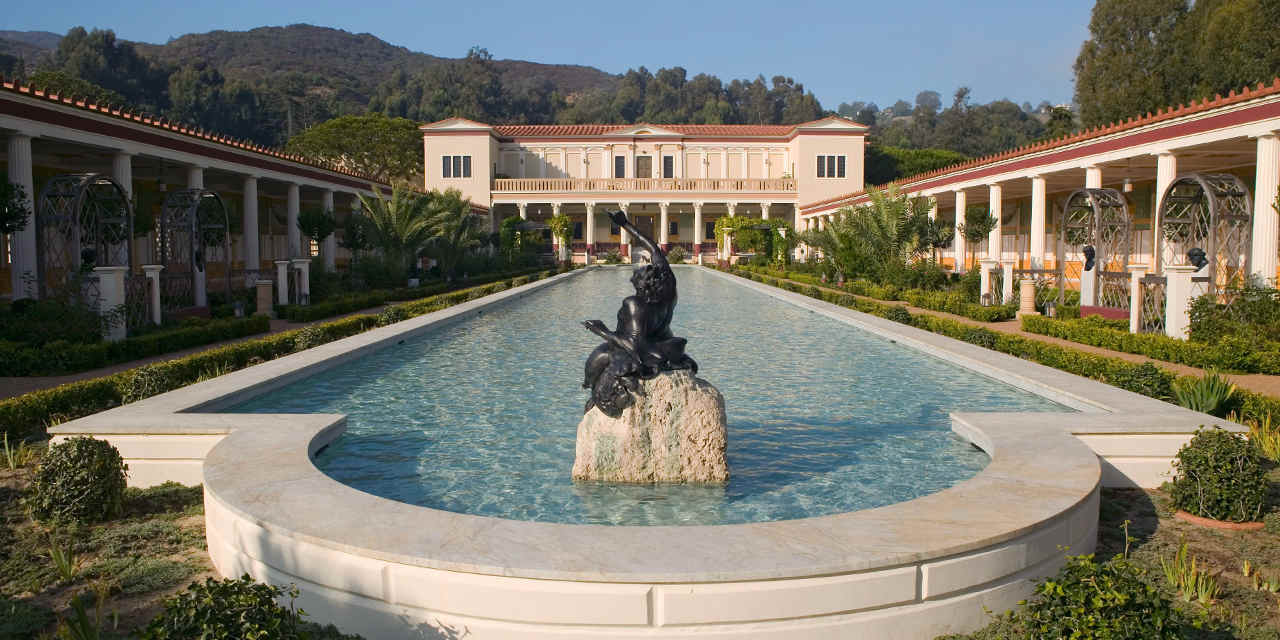
5 Great Tours at the Getty Villa

Looking for a little more as you explore the Getty Villa gardens and exhibits? Take a guided tour for in-depth information and behind-the-scenes details from a museum expert. These tours are offered free to the public at various times through the week. Check the current calendar to see which tours will be offered during your visit; then meet at the Tour Meeting Place outside the Museum Entrance. For more free talks and tours at the Getty Villa, check out the Villa’s Tour page .
Architecture Tour
While the Getty Villa houses more than 44,000 Greek, Roman, and Etruscan antiquities, the Villa is a work of art on its own, modelled after a first-century Roman country house. The 40-minute Architecture Tour highlights various architectural elements of the Villa and offers insights into daily life in the ancient world. Offered multiple times every day.
Garden Tour
Explore the Villa’s four gardens and learn about the ancient Roman gardens that inspired them. This 40-minute tour highlights the garden’s sculptures, fountains, and reflecting pools, along with its 300-plus plant varieties. Foodies may opt for the 30-minute Culinary Garden Tour instead, which specifically focuses on the garden’s edible plants, herbs, and fruit trees and their connection to cooking in antiquity; it’s available on Thursday and Saturday at 2:30 p.m. The Garden Tour is offered multiple times every day.
Collection Highlights Tours
Want to see the Villa’s greatest hits? First-time visitors to the Getty Villa might consider this tour, available once a day on weekdays and twice a day on the weekend. This 50-minute tour highlights many of the major works on display from the Museum’s collection. Offered at 1 p.m. Monday, Wednesday–Sunday; also at 11 a.m. on Saturday and Sunday.
Spotlight Talk
Short on time? Explore the richness of the ancient art housed in the Getty Villa in this 20-minute gallery talk that takes an in-depth look at one major work in the museum’s collection. Offered once a day; see calendar for times.
The Observant Eye
From mythology to death, nudity to wine, key topics in the ancient Greek and Roman world—and their expression in the museum’s collection of art and artefacts—are examined in the 50-minute Observant Eye tour. Offered Monday and Friday at 2:00 p.m.
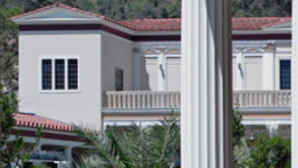
Spotlight: The Getty Center
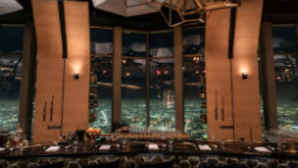
The Getty Center is not just for art lovers. Perched in the hills above West Los Angeles, the main branch of the world-class museum may look like an elevated modernist city. Its dramatic buildings, meanwhile, house galleries filled with masterpieces that might intimidate those not familiar with 17th-century Baroque art—or with the sculptures of Henry Moore or Isamu Noguchi.
But herein lies the beauty of the Getty Center: Whether you go for art, for the free Friday night concerts , for kid-friendly programs, or just to find the perfect place for a relaxing picnic lunch, it has something for everyone. Even better? Admission is free. (You just need to pay for parking .)
Designed by renowned architect Richard Meier, the main Getty Center complex includes the Getty Conservation Institute, the Getty Research Institute, the J. Paul Getty Museum, the Harold M. Williams Auditorium, two cafés, a full-service restaurant, and more than 86 acres of landscaped gardens and terraces to explore. About 14 miles away—in Pacific Palisades, near Malibu—the Getty Villa focuses on ancient Greek and Roman art, housed in a Roman-style country house.
Overall, the Getty features the personal collection of businessman and art collector J. Paul Getty, who saw art as a civilizing influence in society and sought to make it more widely available to the public. Through the work of the J. Paul Getty Trust after his death, the Getty museum now consists of five two-story pavilions featuring hundreds of pre-20th-century European paintings, drawings, illuminated manuscripts, sculptures, and decorative arts., as well as 19th-, 20th-, and 21st-century photographs.
Read on for our guide to this world-class museum—including the hands-on exhibits in the Family Room , the architecture tours , and its on-site hotspots Off the 405 and The Restaurant .

Must-See Gardens at the Getty Center
In between exploring the Getty Center’s indoor exhibits , head outside to visit the museum’s expansive grounds and gardens. From carefully curated gardens to eye-catching sculpture displays (there’s even a garden devoted entirely to the humble cactus), the Getty’s outdoor spaces are both gorgeous and fascinating. To enrich your exploration, download the Getty Center’s audio tour podcast .
Fran and Ray Stark Sculpture Garden
Before hopping on the tram between the parking structure and the main part of the Getty Center, take time to explore the serene Fran and Ray Stark Sculpture Garden. This collection of modern and contemporary sculptures was donated by the trustees of the late film producer Ray Stark and his wife, Fran, and includes sculptures like Henry Moore’s Bronze Form and Isamu Noguchi’s The Tent of Holofernes . This is also a nice spot to relax, thanks to the fountains, secluded seating areas, and skyline views.
Central Garden
The most popular garden at the Getty, the 134,000-square-foot Central Garden was created in 1997 by installation artist Robert Irwin. This is the perfect place to take a break, enjoy a picnic, and participate in another kind of art experience at the Getty: the more than 500 varieties of trees, shrubs, grasses, and flowers are a constantly evolving exhibit that highlights the relationships between nature, experience, and design. From the tree-lined walkway to the bougainvillea arbors and a central pool, all of the plants and structures were selected to accentuate the interplay of colour, light, and reflection. Be sure to make it to the garden plaza to find Irwin’s quote carved into the stone floor: “Always changing, never twice the same.”
Lower Terrace Garden
After exploring the Central Garden, head west to the Lower Terrace Garden, which overlooks the city. Especially fun for younger visitors, this garden features six sculptures, including Walking Flower , The Jousters , and the movable, wind-activated Three Squares Gyratory .
Cactus Garden
Celebrate the king of eco-friendly vegetation at the Getty Center’s South Museum Pavilion. Walk along the raised path to view dozens of cacti of different sizes, shapes, and colours that contrast with the cityscape behind them. If you’re visiting on a clear day, the view beyond the Cactus Garden may extend all the way to the Pacific Ocean.

The Getty Center with Children
The Getty Center may be a sophisticated, world-class museum, but it also has plenty of child-friendly appeal. On most Saturdays throughout the year, there are special family-centred activities at the Getty Center, with additional opportunities in the summer (check the Getty Center family calendar ). But here are a few family-friendly activities you can (and should) do on any day at the museum.
Pick up a GettyGuide
While you’re wandering around the museum, keep the kids occupied with a GettyGuide, a free multimedia guide accessible on your smartphone or on an iPod touch; you can check one out for free (with photo ID) from the GettyGuide desk in the Museum Entrance Hall. GettyGuides provide video and audio clips along with additional details about works of art around the museum, to keep children of different ages interested and engaged. For younger ones, choose the Family Tour, which shares fun facts about art enhanced with music and sound effects. Tweens and teens will dig the Demons, Angels and Monsters audio tour, which highlights the supernatural in the museum’s collection.
Visit the Family Room
For some hands-on fun, head to the Family Room , located in the Museum Courtyard by the East Pavilion. Activities include building a tube sculpture, decorating a giant illuminated book page, or playing with camera lenses and a wall of mirrors. When they’re tired, children can grab a book and lounge on the giant luxurious bed, reclining just like one of the 18th-century French aristocrats seen in the paintings.
Use the Art Detective Cards
Make your museum trip more interactive by adding this self-directed scavenger hunt through the West Pavilion, which asks children to find specific paintings and to look more closely at the art. The four activity cards encourage children to use their detective skills, uncovering clues hidden in paintings to solve the mystery. Art Detective Cards are available outside the Family Room or from the Family Cart in the Museum Entrance Hall, in either English or Spanish. There’s another Art Detective game, too, for the outdoor sculptures in the Central Garden.

Dining at the Getty Center
Planning on spending a full day at the Getty Center? It’s not hard—not only is there plenty to see, but there are more than three meals’ worth of dining options at the Getty to keep you fed. Here are our picks, along the budget spectrum.
Cheap eats: BYO picnic
The Getty Center allows visitors to bring their own food and drinks to enjoy at locations on the Getty grounds. Set up at the picnic tables at the lower tram plaza, if you need to return coolers and supplies to the car, or bring a blanket and lounge on the lawn near the Central Garden. While you can’t BYOB, beer and wine are available for purchase at the coffee carts.
Grab-and-go: Coffee carts
If you just need a quick bite between exhibits, look for one of the coffee carts —one in the Museum Courtyard and one near the Tram Arrival Plaza. Choose from the collection of sandwiches, salads, soups, and snacks, plus espresso drinks, juice, wine, and beer.
Mid-range meals: the Garden Terrace Cafe and the Cafe
If you’re looking for something a bit more substantial than the coffee cart, head to one of the Getty Center’s two on-site cafés. The Garden Terrace Cafe is located on the lower level, underneath the Exhibitions Pavilion. Here you’ll find quick eats in a casual outdoor setting overlooking the Central Garden. Closer to the tram Arrival Plaza, you’ll find the self-service Cafe with hot and cold entrees, international cuisine, seafood, and pizzas.
Fine dining with a view: The Restaurant at the Getty Center
For an elegant lunch or dinner with one of the best views in Los Angeles, head up to The Restaurant , with seasonally inspired menus, a distinctive wine list, and a full bar. Try out the four-course prix fixe menu inspired by the current exhibit or indulge in The Restaurant’s Sunday Brunch. Inside the 150-seat dining room, you can check out the large, mixed-media art installation by L.A. artist Alexis Smith or snag one of the 75 seats on the outdoor terrace, which boasts views of the Santa Monica Mountains and the Pacific Ocean. Reservations are recommended (book through OpenTable or by calling the Getty directly); limited same-day reservations may be available at the door or at the Museum Information Desk.

Getty Center Travel Tips
While there are no entrance fees for either the Getty Center or the Getty Villa , you do have to request a free ticket for the Villa, and you typically need to pay $15 for parking at either location. While that parking fee covers the whole car—a good reminder to carpool—there are a few other ways to both maximize that parking fee and your time at the Getty.
Visit after 3 p.m.
Don’t need all day at the museum? Visit the Getty Center or Getty Villa after 3 p.m. and pay only $10 for parking. While the Villa closes at 5 p.m. most of the year and the Getty Center at 5:30 p.m., both locations stay open later during the summer months on certain weekend days. The Getty Center remains open until 9 p.m. on Fridays and Saturdays, and the Villa is open until 9 p.m. on Saturdays.
Bike, bus, Uber, or Lyft
Avoid the parking fee altogether by taking public transportation , a bike, or a ride-sharing service like Uber or Lyft to the Getty. Bicyclists can park for free on the entry level of the parking structure. Visitors using Lyft or Uber can be dropped off at the designated turnaround area, located outside of the parking structure. See the Getty Center and Getty Villa pages for the specifics on buses and light rail options.
Visit both in one day
Visitors planning to hit both the Getty Center and the Getty Villa in one day can get a same-day parking coupon, good for parking at both locations, for just one $15 fee. (Or $10, if you’re arriving after 3 p.m.) Just visit the Museum Information Desk at either the Getty Center or the Getty Villa to pick up your complimentary same-day parking pass. (One hitch: The offer is not valid on Mondays or Tuesdays.)
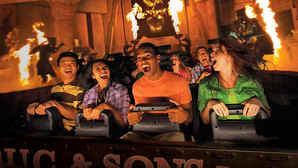
California’s natural beauty and diverse attractions make it the perfect place to plan a family road trip. With so many places to see in one very large state, ...

Shopping in The O.C. is almost as legendary as surfing. Start at expansive South Coast Plaza, California’s largest luxury shopping complex, with iconic luxury brands such...

With a nickname like “Surf City, U.S.A.,” Huntington Beach is the obvious place for this 9-day, sun-and-wave extravaganza, the world’s largest surf event. Top pros...

Guide To The Getty Villa In Los Angeles, What To See + Tips
Looking for a guide to the Getty Villa? Look no further! The Getty Villa is a fantastic one-of-a-kind museum that brings ancient art and architecture to life. I loved my experience.
The villa is a pristine recreation of a seaside Roman estate housing billionaire oilman J. Paul Getty’s collection of Greco-Roman antiquities.
Through the museum’s exhibits, you can track the history of the ancient world from 3,000 B.C. to the late Roman Empire in 400 A.D.
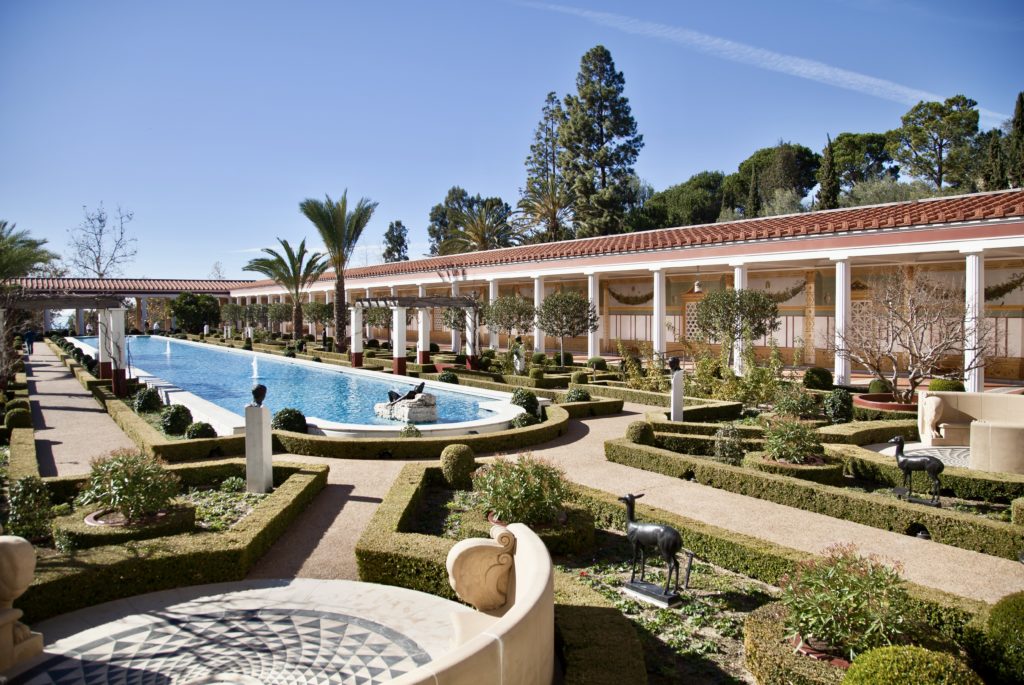
It seems a half mad idea to recreate an ancient villa to house your art. But Getty, with his obsession for antiquity and a Caesarian attitude, must have enjoyed the challenge of creating something so unique.
In this Getty Villa guide, you’ll find a history and overview of the collection, a list of must see masterpieces, and tips for visiting.
History Of The Getty Villa
J. Paul Getty was an American billionaire, oil tycoon, and art enthusiast. He came from money and power.
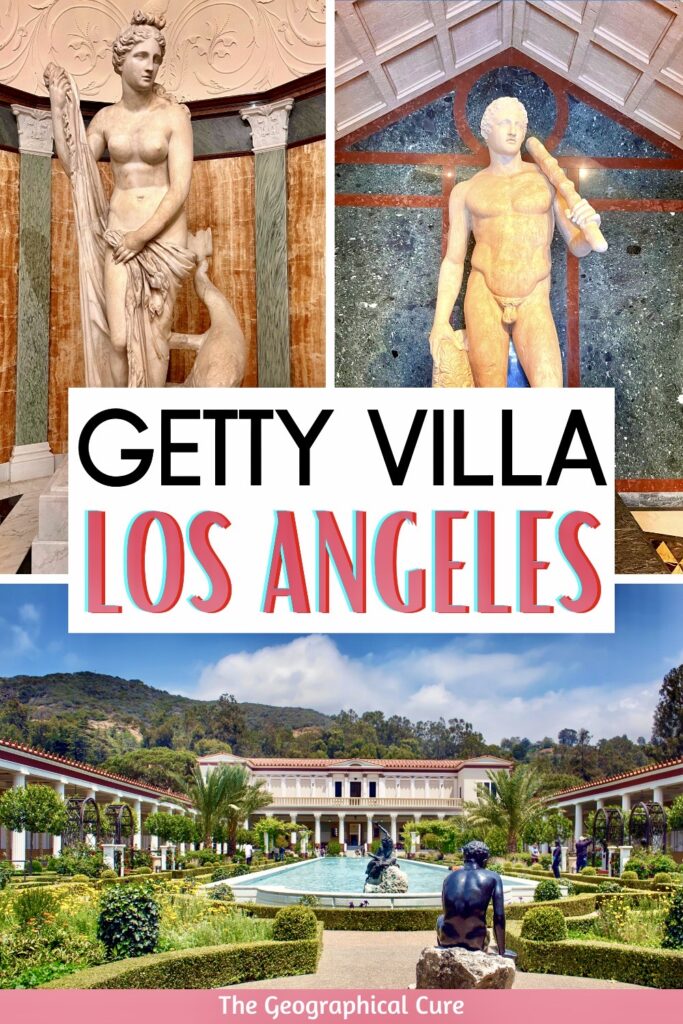
With a loan from his father, he invested in oil wells in the Middle East and became “the richest man in the history of the world.”
But Getty didn’t just have oil fever. He started seriously collecting art in the 1930s.
He was a passionate and lifelong collector who though collecting art was “one of the most exhilarating and satisfying of all human endeavors.”
Getty traveled widely throughout his life and made a habit of visiting archaeological sites. Trips to Italy left him with a taste for bronze and marble sculptures from ancient Greece and Rome.
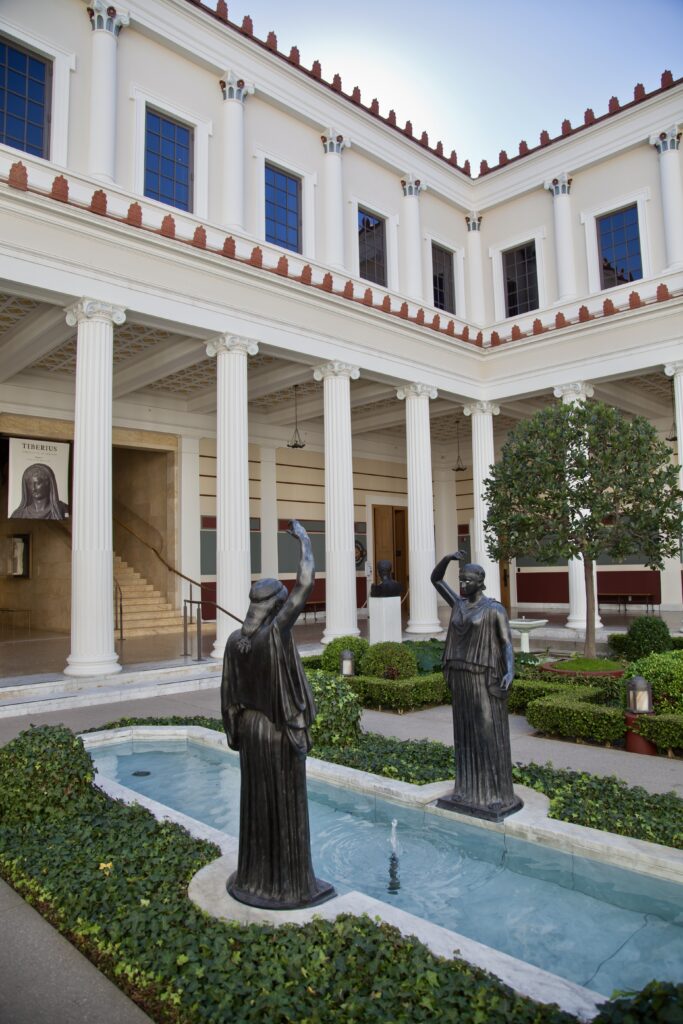
But Getty didn’t want to just admire them in private.
He wanted to share his art with the world and let others travel back in time. By doing so, he hoped to “further the diffusion of artistic and general knowledge.”
In the early 1970s, Getty set about building a museum to house his collection on his 64 acre Malibu ranch. He modeled it on a luxury Roman villa from 40 B.C., the Villa dei Papiri excavated near Herculaneum and Pompeii.
READ : Ultimate Guide To Pompeii
The villa was owned by the wealthy Roman consul Lucius Calpurnius Piso Caesonius. He was the father-in-law of Julius Caesar, a Roman whom Getty greatly admired.
The villa’s inhabitants lived surrounded by sculpture. It was a way to demonstrate their wealth and culture and earn an air of prestige.
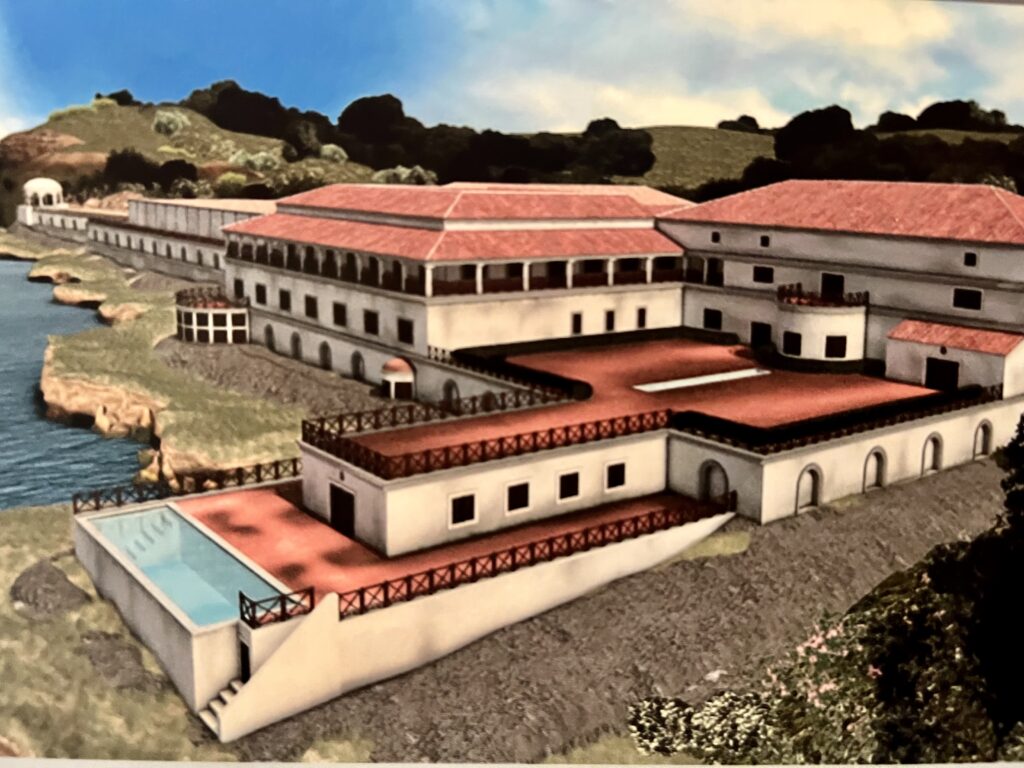
In 79 A.D., the eruption of Mt. Vesuvius destroyed the villa and it was only re-discovered in 1750. Archaeologists uncovered underground tunnels, sculptures, frescos, stone pavements, and other artifacts.
In particular, 1,100 charred papyrus scrolls were discovered in the villa’s library, giving the villa its nickname the “Villa of Paper.”
The scrolls including the writings of Philodemos of Gadara, a philospher who was the patron of Caesonius. This links the villa to Caesonius.
Modern excavations of the villa have uncovered frescos on walls and geometric patterned mosaic and terrazzo floors. But the vast majority of it remains buried.
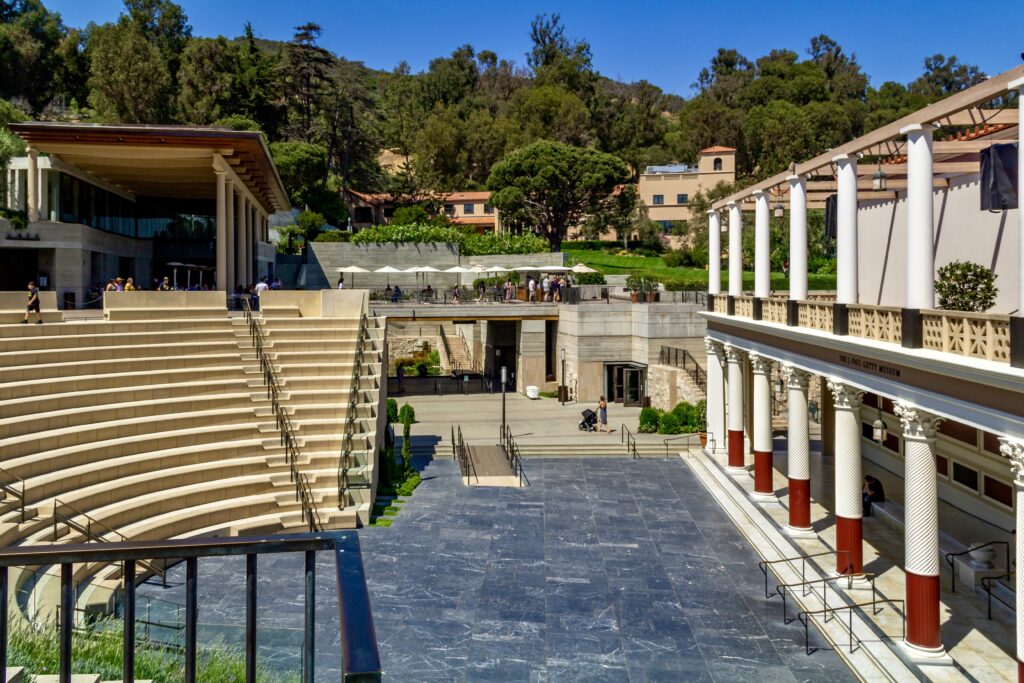
The team that Getty hired to recreate the ancient villa included architects, artisans, and archaeologists.
Getty reimagined the villa as an archeological site. Walls and a concrete courtyard below the villa create the sense of looking down into the dig pit.
Much of the Villa dei Papiri remains un-excavated and its elevations are mostly still a mystery. Therefore, architects based many of the Getty Villa’s architectural and landscaping details on other ancient Roman houses in the towns of Pompeii, Herculaneum, and Stabiae.
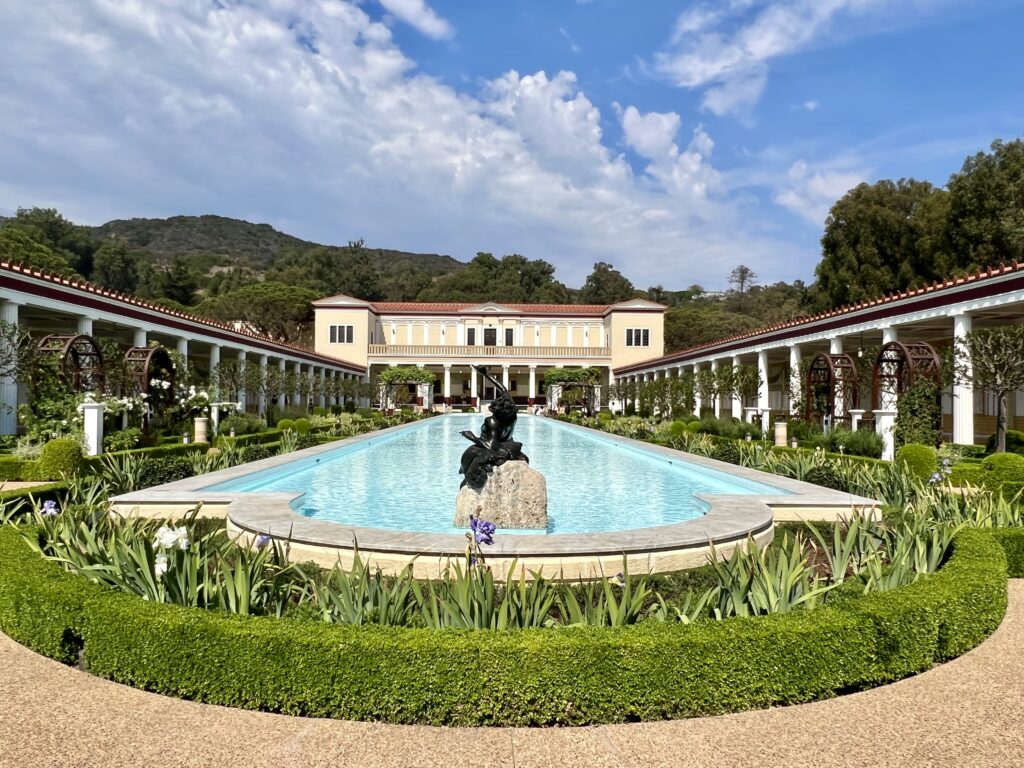
After a 9 year $275 million renovation, the Getty Villa opened to the public in 2006, becoming the home of the Getty Center’s Antiquities Collection. In 2015-18, further renovations were completed. The result is simply stunning.
Getty famously said: “Go to Pompeii and Herculaneum and see Roman villas the way they are now [in ruins] — then go to Malibu and see the way they were in ancient times.”
The Getty Villa can draw mixed reactions. Some art critics deride it for blurring the line between actual antiquities and a faux reproduced villa-environment.
This seems a silly criticism to me, as the difference between the two is readily apparent. The “atmosphere” of being in a reimagined Roman villa doesn’t detract from the academic quality of the art in any way. If anything, it enlivens the experience, just as Getty intended.
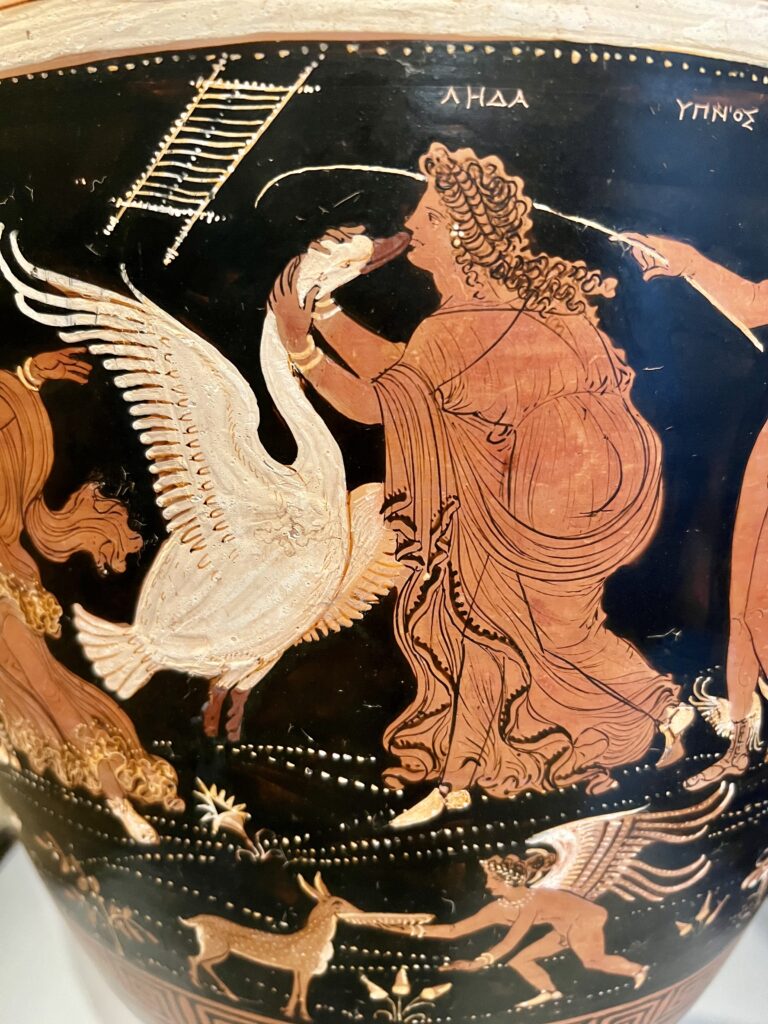
Overview Of The Getty Villa
The Getty Center is an immersive experience. It’s as much about architecture as art. Even if the museum didn’t have any art, it would be worth the price of admission just to see the reimagined Roman villa.
But the art is spectacular. You’ll almost feel like you’re in Rome or Pompeii.
There are 33 galleries on two levels that are organized thematically. 5 galleries are dedicated to temporary exhibits.
There are 1,000 antiquities on display, including sculpture, busts, pottery, paintings, jewelry, mosaics, and frescos. If you’re a history buff, you could spend hours perusing these galleries.
The first floor showcases the Greek, Etruscan, and Persian collections. In addition, there’s an area explaining Getty’s love for collecting artifacts from antiquity as well as his life and legacy. The second floor is exclusively dedicated to Roman art.
You can check out this online map to get oriented before your visit.
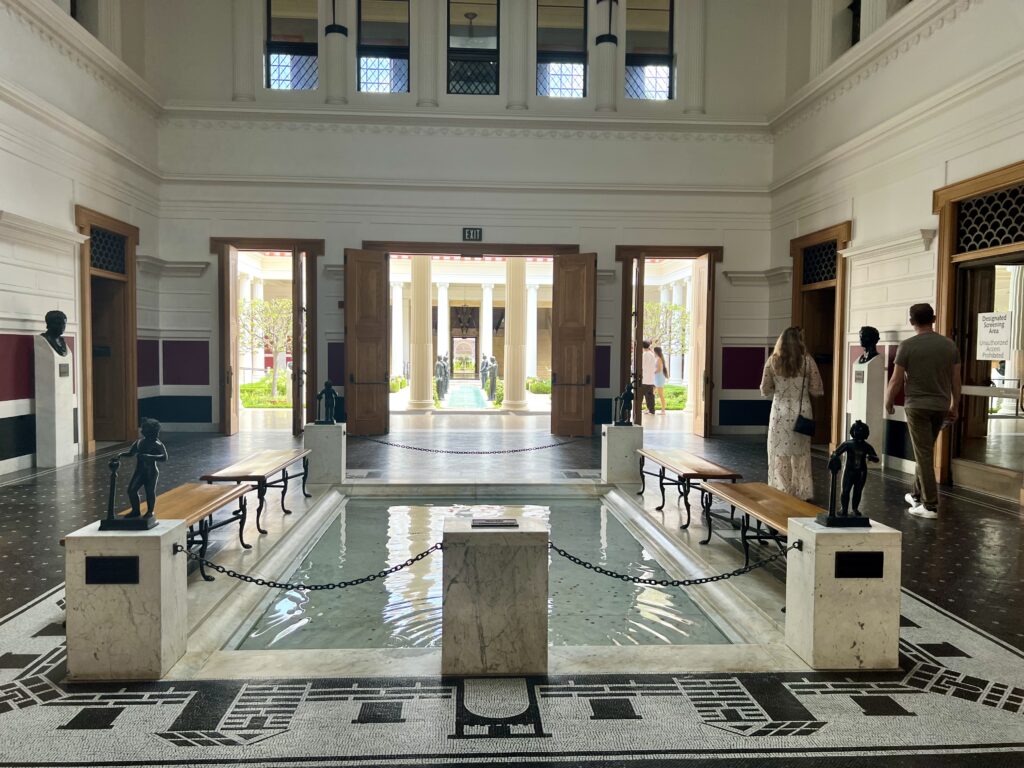
Guide To The Getty Villa: What To See
Here are 15+ of the top masterpieces and spaces you’ll see on a tour of the Getty Villa, in roughly the order you’ll encounter them on a visit.
You first enter into the atrium through a colonnaded facade and a floor paved in white marble.
Entry squares like this were common in the 2nd century B.C. They were the heart of a Roman house and designed for strolling and conversation.
Ionic half columns support a coffered ceiling with an open skylight, set over a square pool. The skylight has a coral frieze with lion’s head drain spouts. The geometric floor is copied from the House of the Faun in Pompeii.
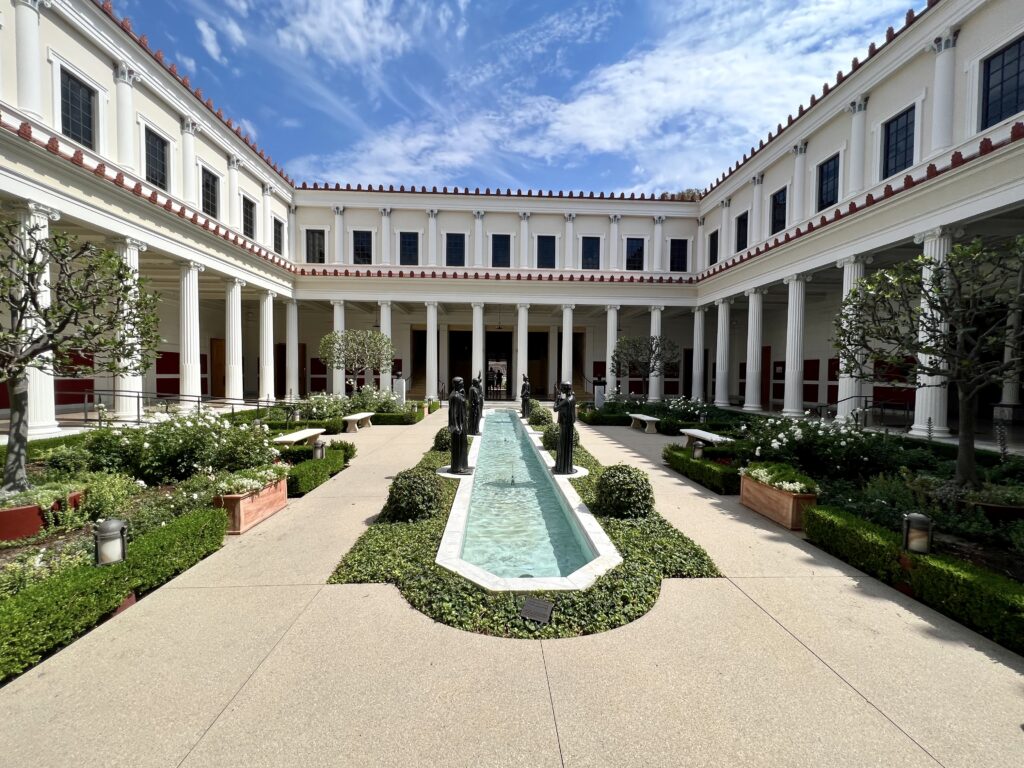
2. Inner Peristyle
The inner peristyle is a pleasing and intimate green space, and was also common in villas from the 2nd century B.C. Inspired by the House of the Silver Wedding in Pompeii, the space is defined by 36 Ionic columns surrounding a garden. At each corner is a white marble fountain.
The colonnade is surrounded by walls decorated in the First Pompeian Style. The columns were modeled after the House of Colored Capitals in Pompeii. The ceiling was imitates the Street of Tombs in Pompeii
The peristyle is home to some of the Chiurazzi Bronzes . The originals are in the Archeological Museum of Naples and reproductions are on display at the villa.
The bronze statues are of mythological women who seem to be drawing water from a stream. They’re set in marble bases around the pool.
Legend holds that the King of Argos ordered his 50 daughters to kill their Egyptian husbands on their wedding night. One daughter defied her father’s mandate. Her grateful father-in-law exempted her from her sisters’ agonizing fate — eternal water haulage.
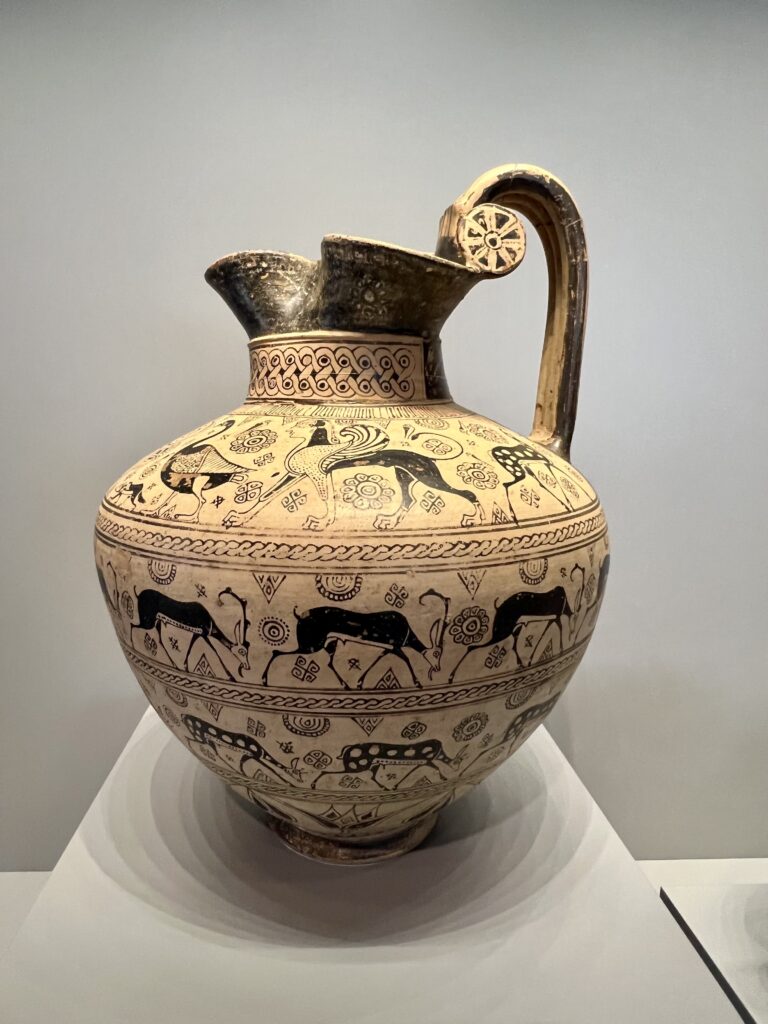
3. Athenian Vases
The Getty Villa houses a large collection of Athenian vases, which in ancient times were used for drinking, serving, and storage.
They were initially made with fired clay and the “black figure technique.” That technique depicted figures in glossy black, with finely incised details. Sometimes red and white colors were added.
By 500 B.C., new techniques had developed. Artisans used red figures, gilding, and further refinements of shape.
They decorated the vases with deeds of the gods and heroes, scenes from domestic life, or sporting events like chariot races. Artists signed some of the vases, so we know their identities.
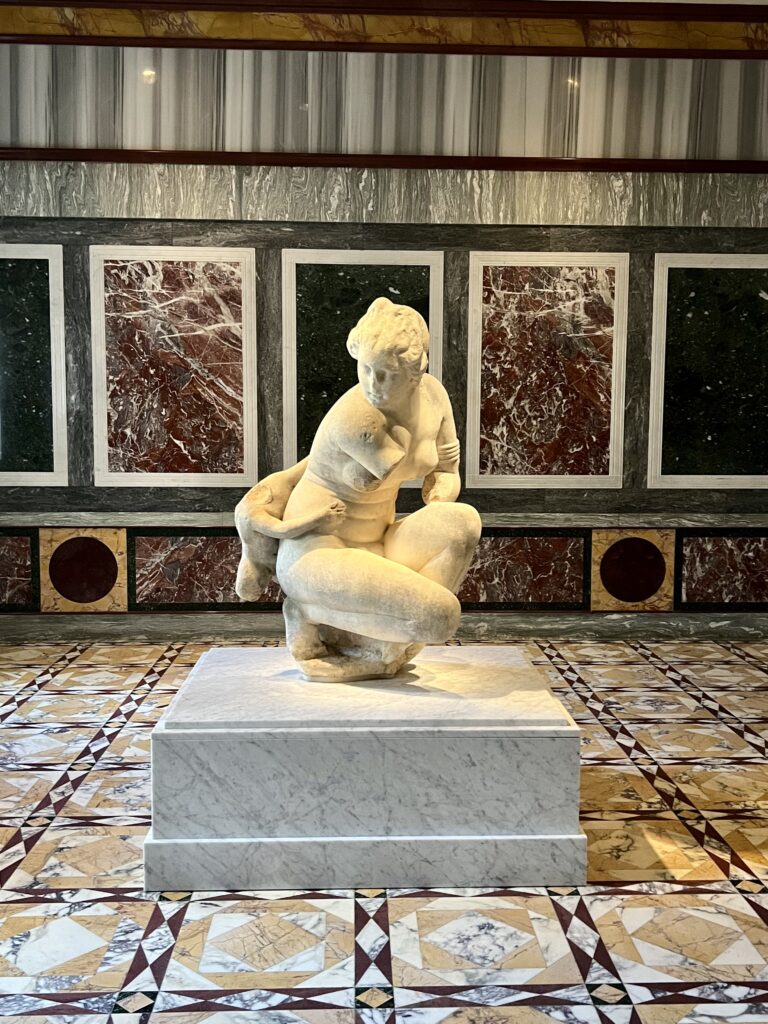
4. Hall of Colored Marbles & Crouching Venus
This “status symbol” gallery is a luxurious space. The hall gets its name from the 14 different varieties of marble used.
It showcases the types of marble that would have adorned the houses of wealthy Romans in antiquity. Marble was used for floors, walls, and fountains.
The marbles in this room were inspired by homes in Pompeii and Herculaneum. The hall’s floor is cut from ancient salvaged pieces.
In the center of the room is the Crouching Venus sculpture. It’s the first major sculpture you’ll see at the villa and one of Getty’s earliest acquisitions. It’s a larger-than-life-size statue of the goddess, kneeling down to bathe with her son Cupid.
In the 18th century, a well known restorer added arms to Venus and arms and legs to Cupid. These were all removed before Getty bought the statue.
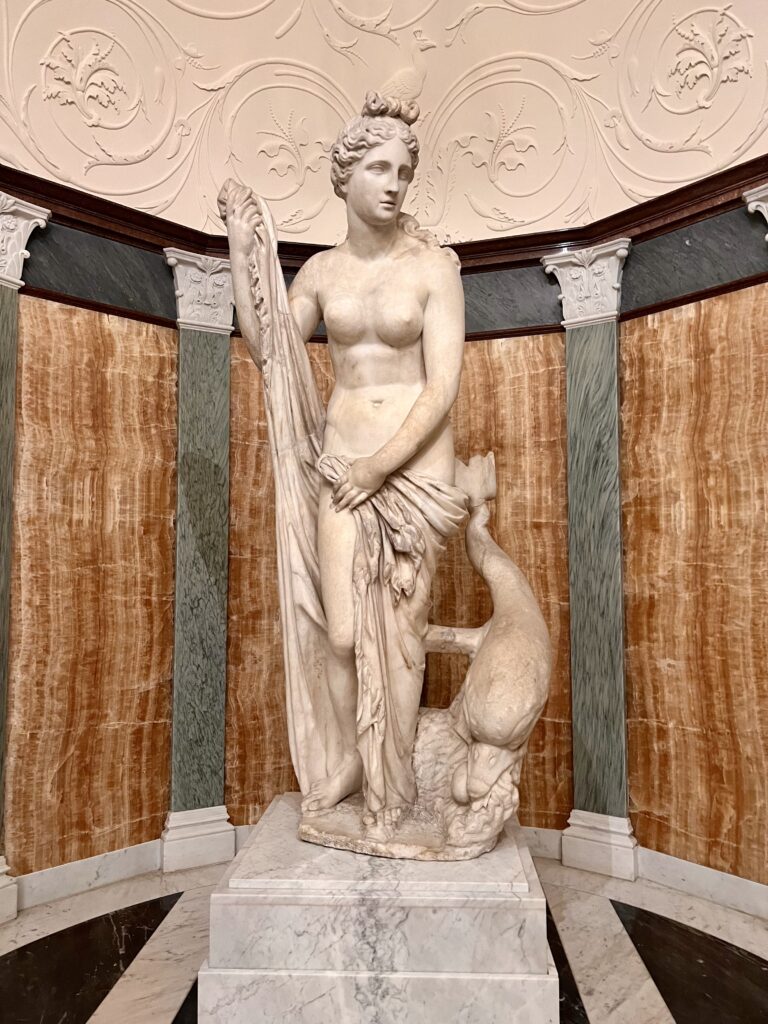
5. Basilica & Venus Statue
Right next door is the Basilica, another gorgeous room clad in marble. In ancient Rome, a “basilica” was a large public hall. But sometimes they were added to private homes and used as shrines.
The basilica is lined with 8 white marble Corinthian columns, topped with elaborate multi-colored capitals. It has a vaulted and coffered ceiling, with stucco work derived from Pompeii.
The intricate marble floors were made with ancient stone fragments in a design copied from the ancient Villa dei Papiri. Statues stand in bays in front of recessed honey colored onyx windows on the side walls.
Under a half dome in the apse is a marble statue of Venus with some modern restorations. It’s a variant of the famous Venus de Milo sculpture in the Louvre . Venus is accompanied by a dolphin, alluding to her birth from the sea.
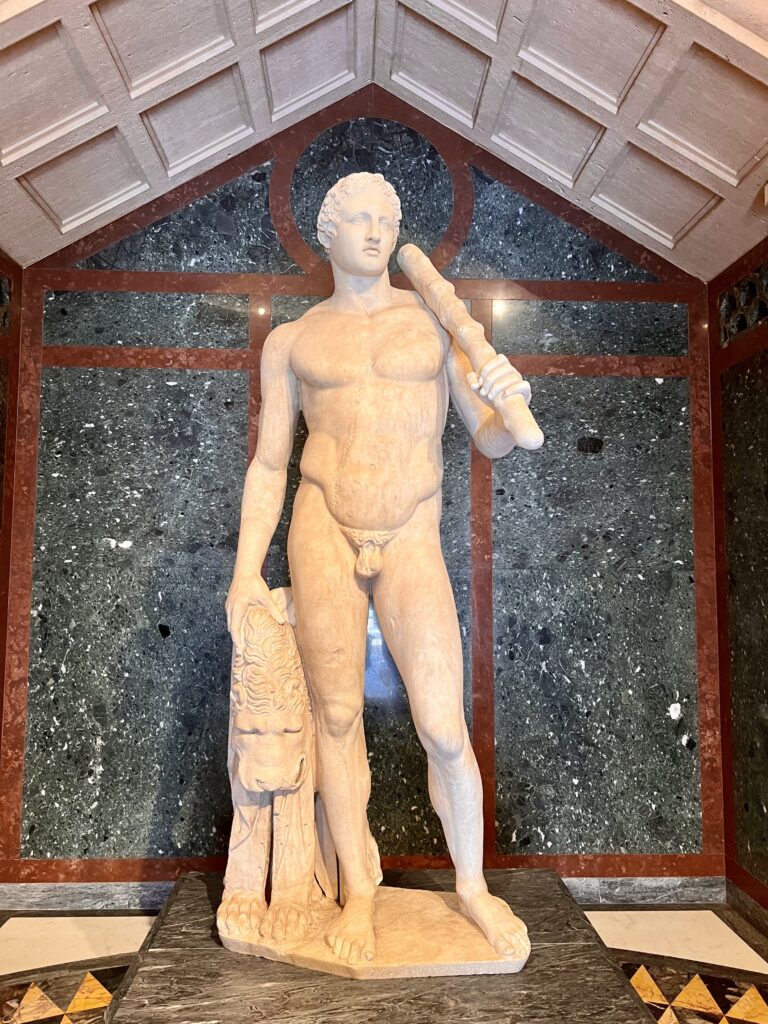
6. Temple Of Hercules & Landsdowne Hercules
The Temple of Hercules is another glittering marble room. The elaborate marble floor is a work of art itself, composed of 4 million pieces of stone.
It reproduces a 1st century pavement from the Villa dei Papiri. Yellow and gray triangles form a geometric pattern of 22 concentric circles.
In the center is an illusionistic polychrome marble circle. The original circle was one of the first things to be excavated at the ancient villa, marking the official discovery of the Villa dei Papiri. The original is in the National Museum of Naples.
The centerpiece of the room is the famous Landsdowne Hercules . It’s one of the Getty’s prize possessions and the piece that inspired Getty to recreate the Villa dei Papri. He purchased it in 1951 from the Marquess of Landsdowne.
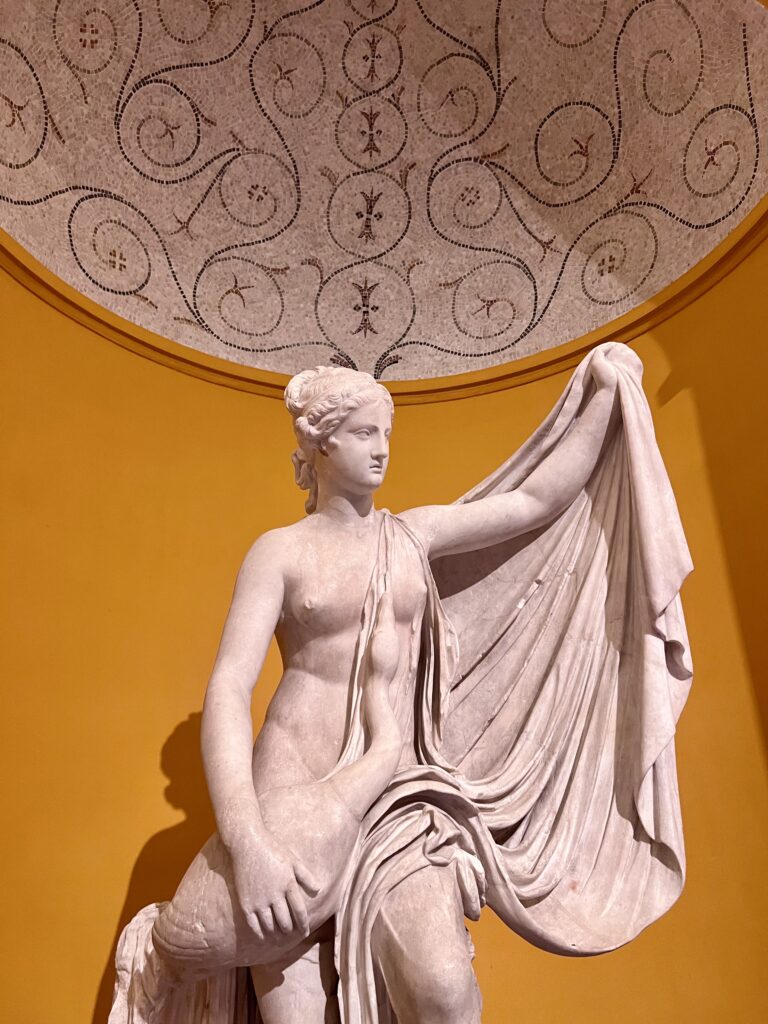
The statue stands in a niche in front of green marble and red porphyry. This kind of room wouldn’t have existed in a typical Roman villa. It was created specifically to house the statue.
The Landsdowne Hercules was discovered in 1790 near Hadrian’s Villa in Tivoli . Getty acquired it in 1951. Hercules looks buff and carries his trademark club and lion skin.
In this room, you’ll also find a Portrait Head of Tiberius and a statue of Leda and the Swan . Leda was acquired at the same time as the Hercules .
Getty purchased Tiberius , also known as the Landsdowne Tiberius , in 1971. For over a century, the head was attached to the wrong body. It depicts Tiberius with his recognizable thin lips and eyebrows.
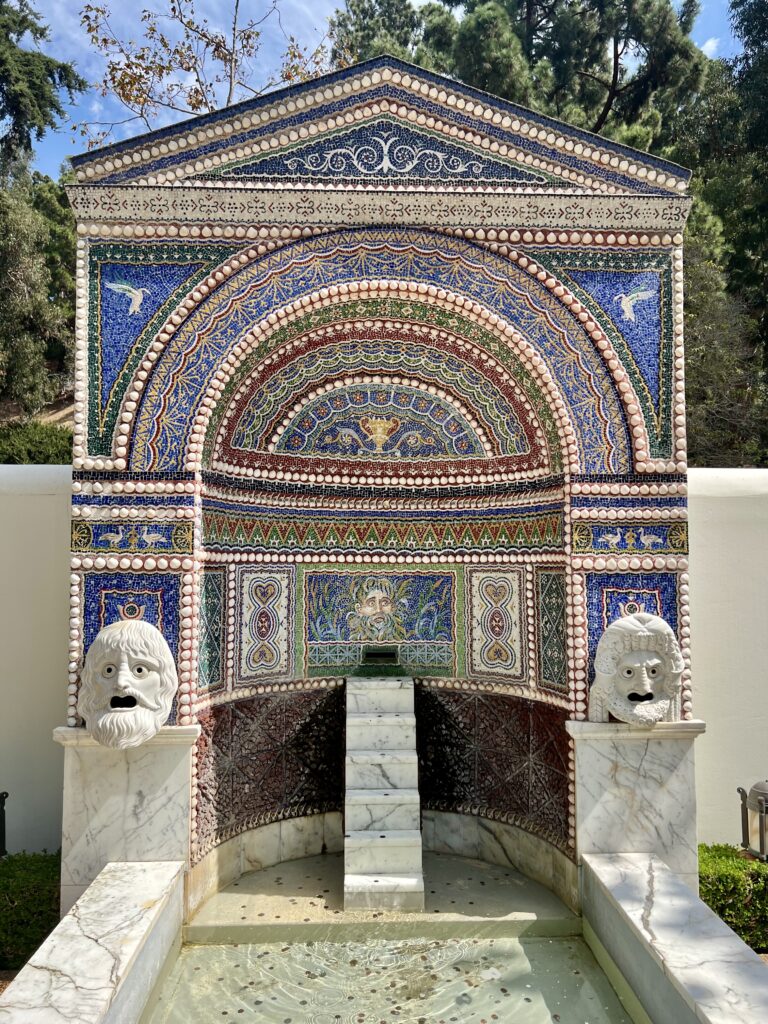
7. East Garden
Two bronze doors then lead to the East Garden, which is planted with mulberry trees, laurels, boxwood, ivy, and ferns. It’s one of the quietest and most tranquil spaces in the villa.
A fountain in the center was copied from the Villa dei Papiri. Water cascades from life size bronze animal heads, include civets.
The spectacular fountain on the wall is an exact copy of the Great Fountain of Pompeii. It’s made of colorful mosaics and shells and adorned with theater masks.
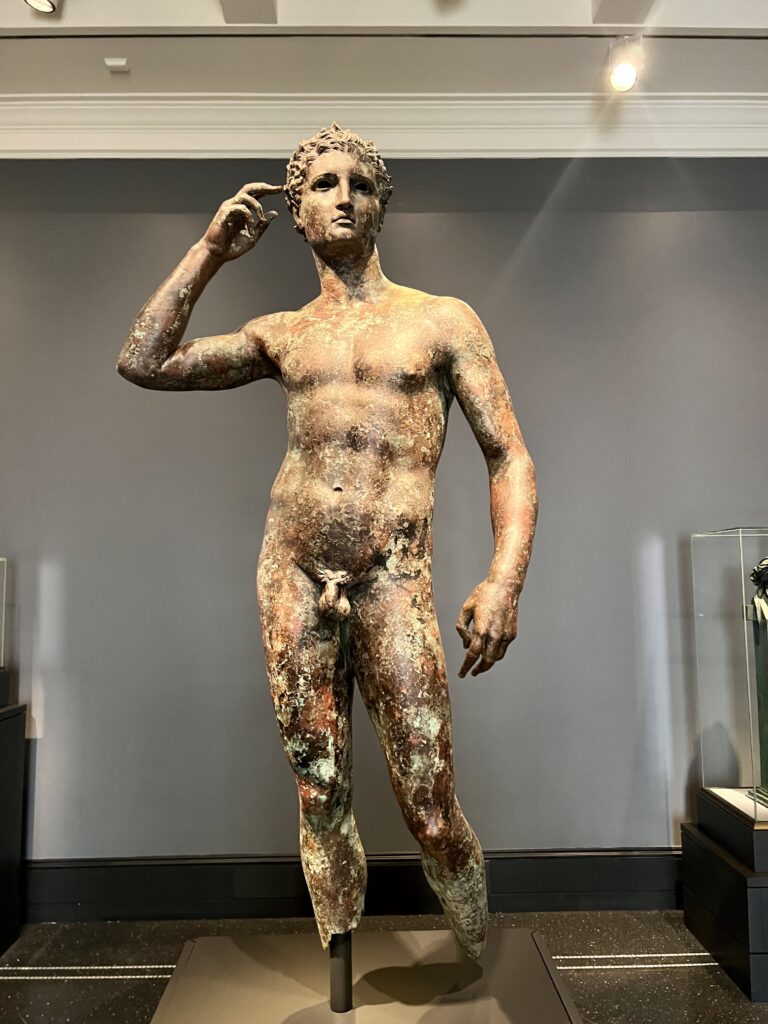
8. Getty Bronze
The 2,000 year old Getty Bronze is the most priceless and famous piece in the Getty Villa collection. It’s also known as the Statue of a Victorious Youth . The sculpture may remind you of Michelangelo’s David in Florence’s Accademia Gallery .
Kept in a climate controlled room, it’s a high caliber bronze Greek statue of a handsome male athlete with good hair. He’s about to remove his wreath and dedicate it to the gods.
Ancient bronze sculptures from Greece are exceedingly rare. Only a handful survive today.
Bronze is an extremely precious and expensive material. Most often, the bronze was melted down for metal.
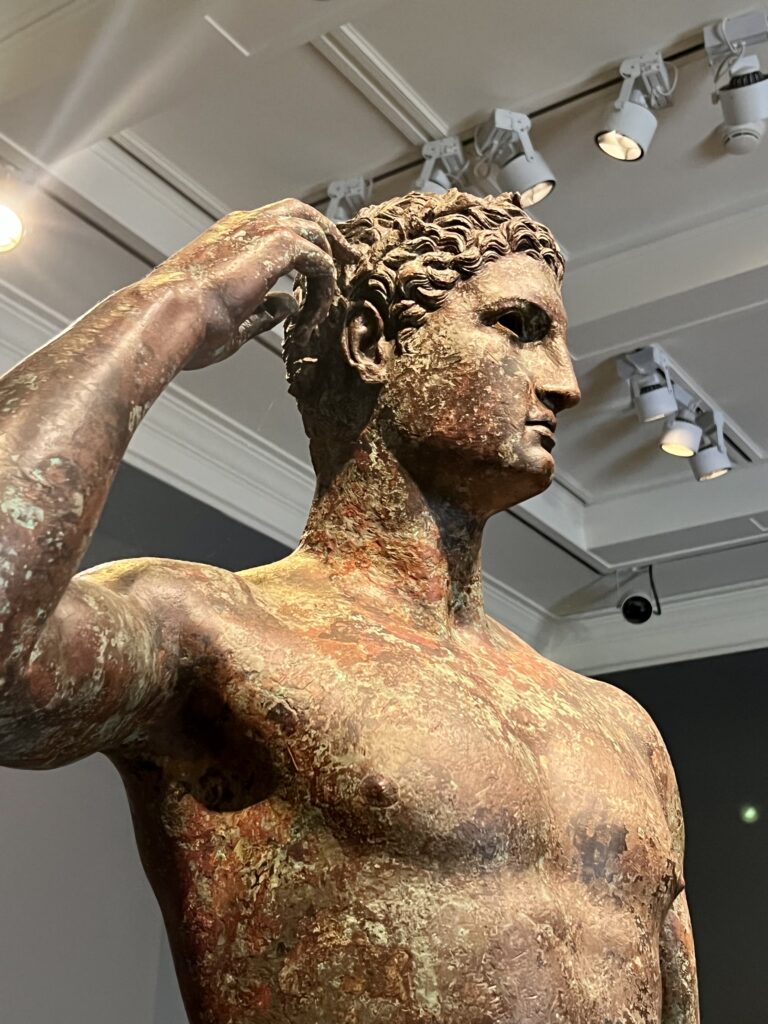
The statue was preserved by a cosmic accident. It was submerged and preserved in a shipwreck in the Adriatic Sea, and only discovered in the early 1960s. As a result, the body, once golden, is now a mottled green and brown.
Italy has asked for the return of the sculpture. But the Getty maintains that the statue was bought in good faith (for $4 million), after it had been retrieved in international waters. And, in fact, they have an extemely good case against forfeiting the rare statue.
In the same room, you’ll also see the Head of a Man from 150 B.C. The bust is of exceptional quality and very expressive, indicating that he was an important man.
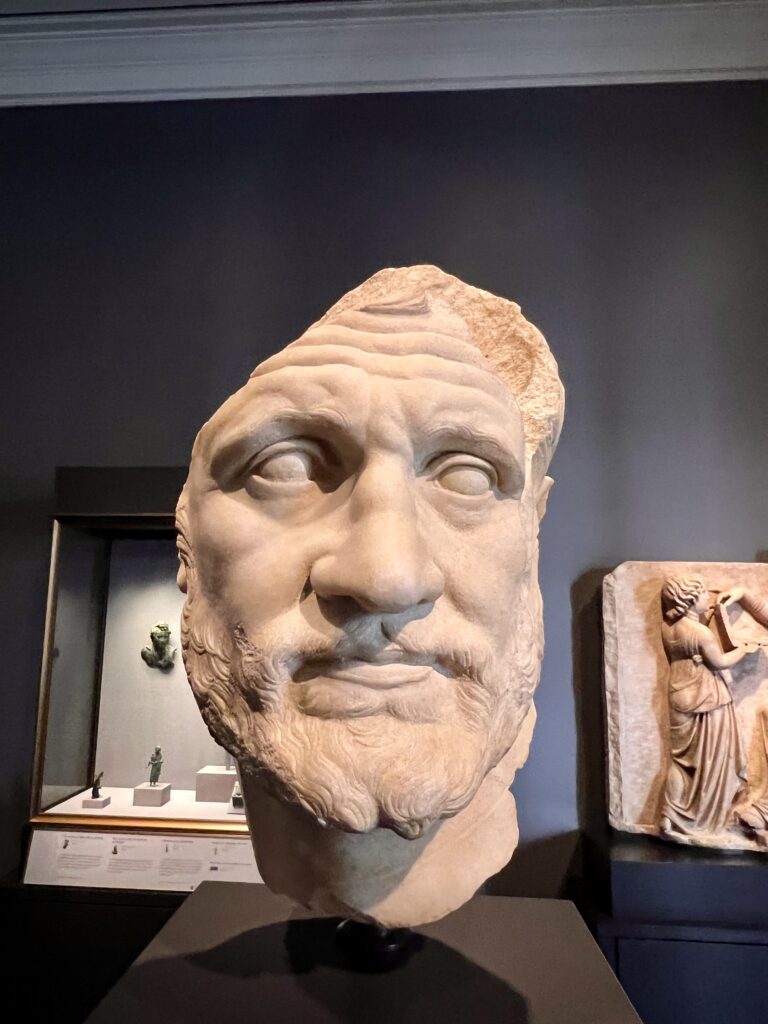
9. Tablinum
A tablinum was an important room in a Roman household. It was the main reception room where the host entertained guests. It stands between the inner and outer peristyles.
The tablinum is ornate and richly decorated, with colorful marble inlaid in geometric patterns on the floors and walls. Dating from late 1st century, the designs are replicated from different villas in Herculaneum.
The ceiling has recessed arched panels. There’s an illusionistic vine motif, which incorporates floors, birds, cupids, and fruit. The floral elements were intended to “link” the inner and outer gardens.
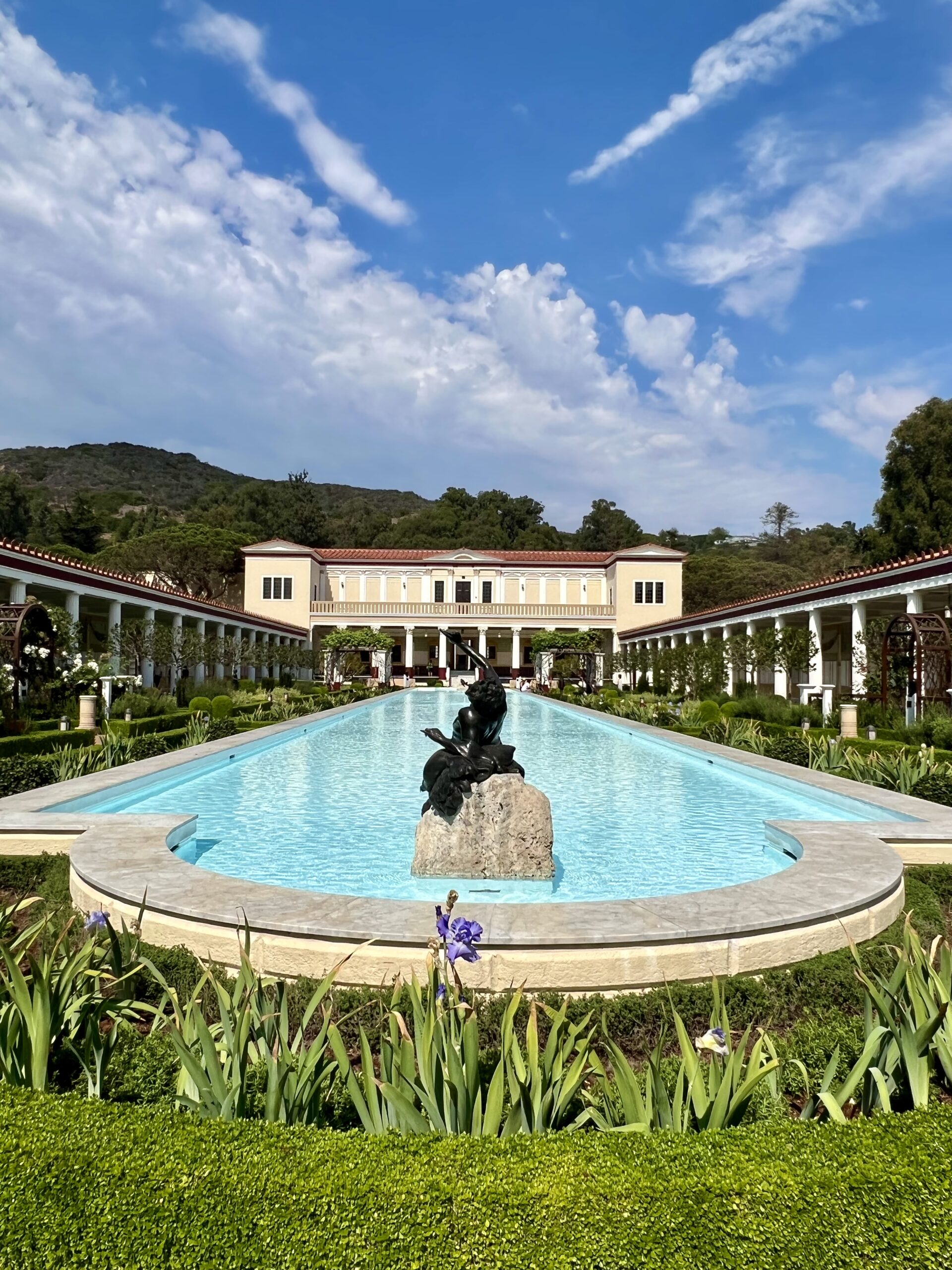
10. Outer Peristyle
Two bronze doors open from the Tablinum onto the Outer Peristyle. This is the heart of the Getty Villa and its largest garden space.
It has a central reflecting pool running its length, 1,000 Mediterranean plants, sculptures, and sybaritic bronze statues. It’s framed on each side by porticos, with columns copied from the basilica at Pompeii.
You can walk in the arcaded pathways. They are decorated with tromp l’oeil frescos in the Second Pompeian Style and blood red porphyry marble floors.
The north wall features frescos of landscapes and architecture copied from the Villa dei Papiri and another villa in Oplontis. Frescoes with theatrical masks on garlands are copies of those from the Villa of Publius Fannius Synistor.
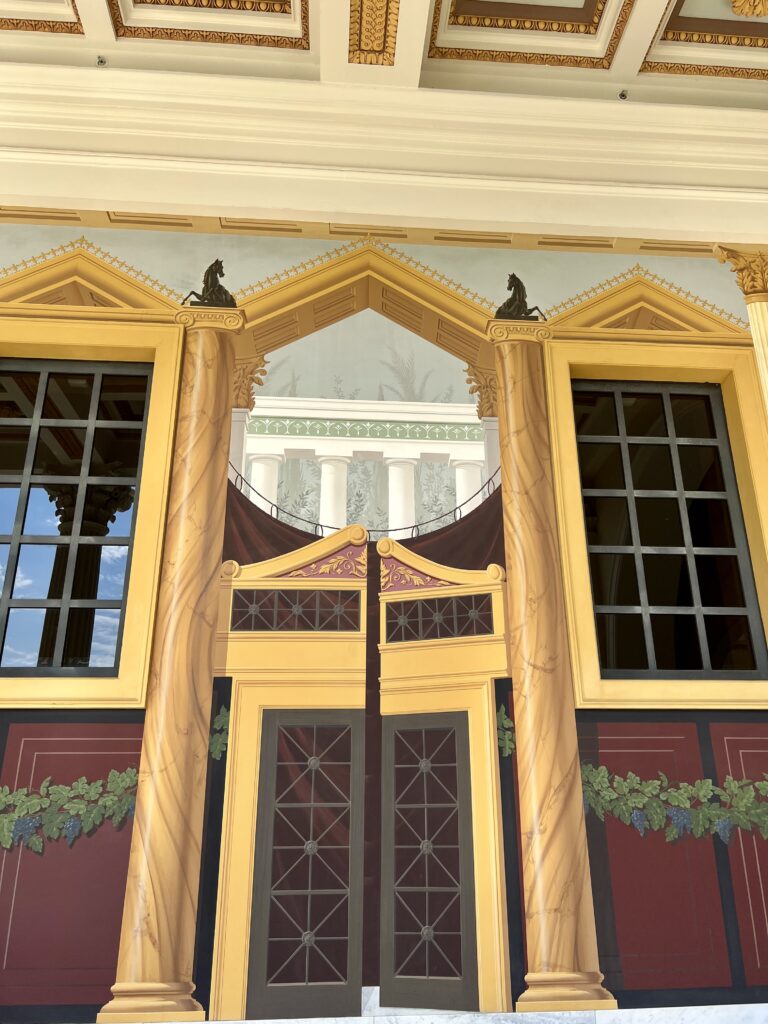
There are two square arbors covered with grape vines. There are myriad plantings, but I loved the pomegranate trees best.
In and around the pool are copies of bronze statues, including half-man half- goat satyrs. You’ll also find semicircular benches to rest, copied from ones in Pompeii.
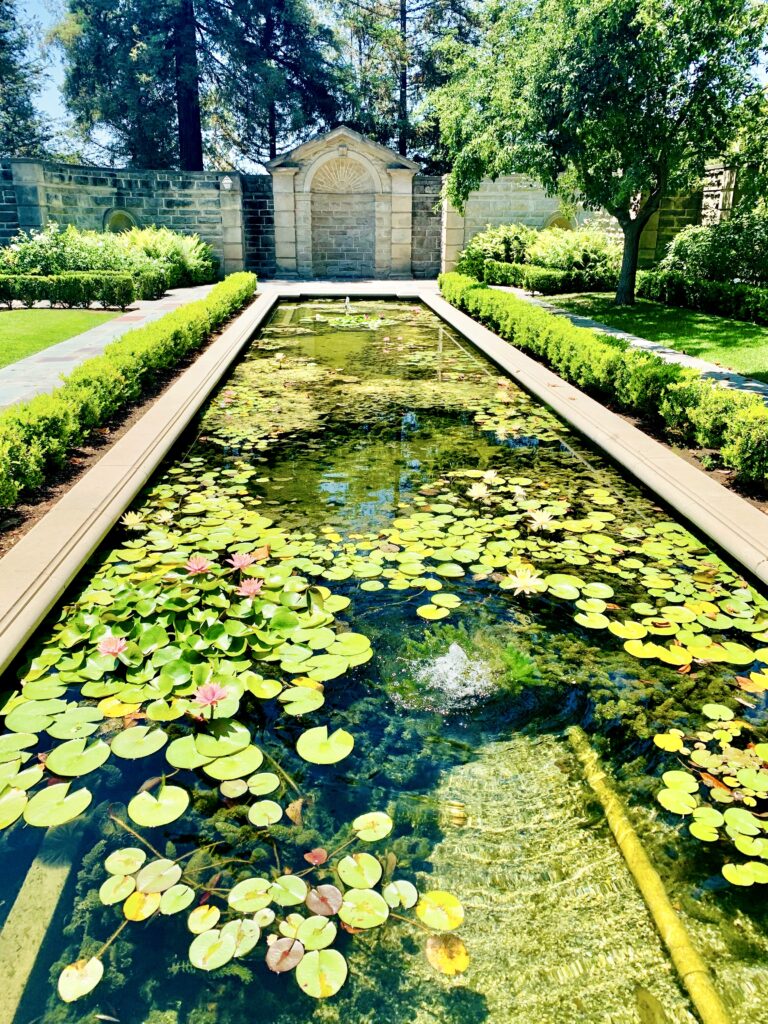
11. Herb Garden
Immediately to the west of the outer peristyle is the Herb Garden. Like nearly everything at the villa, the garden was based on the original herb garden at the Villa dei Papiri. It’s often missed by visitors because it can’t be seen from many villa locations.
Most wealthy Romans had herb gardens, which were used for medicinal and culinary purposes. You can inhale the sweet ascent of lavender, mint, basil, and thyme. You’ll also see a lovely lily pond, with a whimsical waterspout depicting Silenos, a friend of Dionysis.
12. Funerary Relief of Hadirat Kathina
Acquired by the Getty Villa in 2019, this is a limestone funeral relief renowned for its intricate carving. Dating from around 200 A.D., it depicts a bejeweled woman with an Eastern headdress.
It was once adorned with golden paint. You can still see flicks of its original colors, though time has stripped much away.

13. Roman Floor Mosaics
On the second floor, you’ll see walls mounted with large Roman mosaics. Mosaics were popularized in the late 2nd century B.C.
Elaborate mosaics were used to decorate luxurious domestic and public buildings across the broad expanse of the Roman Empire. The mosaics transformed entire rooms into spectacular settings of vibrant color, figural imagery, and abstract design.
The floor mosaics often depicted violent and combative scenes of hunting and savagery. For example, in the mosaic above, a lion viciously chomps on the back of a wild ass.
On a calmer note, you’ll also see a lovely mosaic of a peacock with a long multi-colored tail. Peacocks had special significance and were associated with immortality.
READ : Guide To Sicily’s Villa Romana del Casale
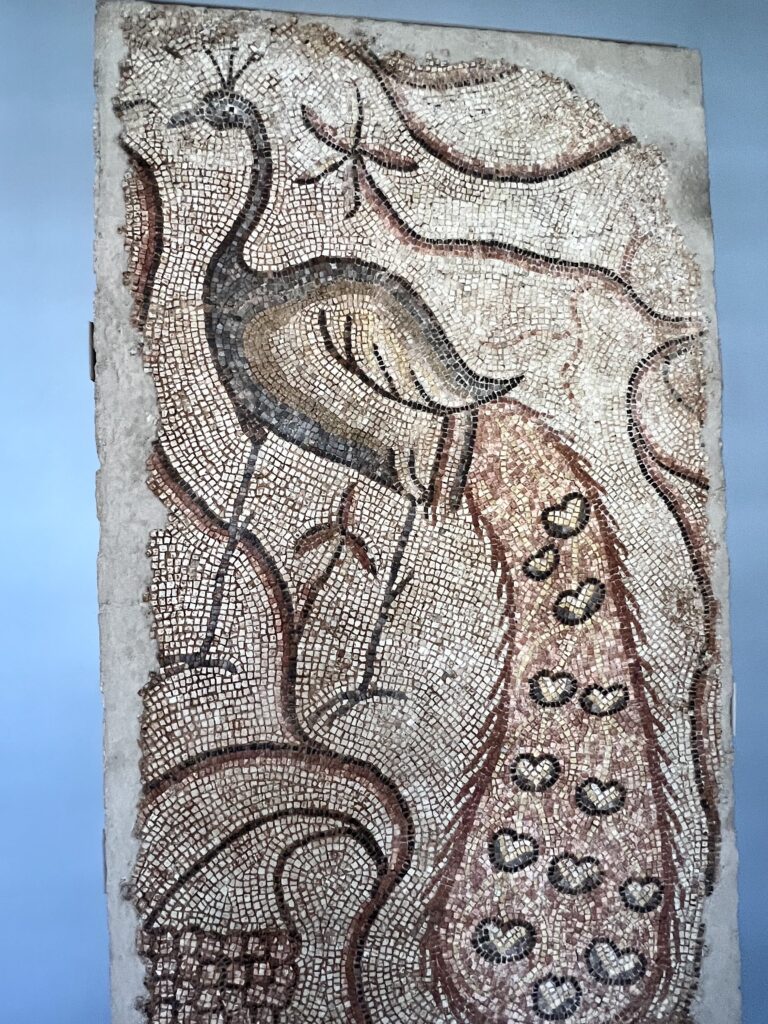
14. Boscoreale Frescos
In another room, you can admire frescos from the black and white rooms of the Villa of Numerous Popidius Florus at Boscoreale. The villa dates from the early 1st century B.C. and was excavated in 1905-06.
In contrast to the fancy seaside villas of Pompeii, Boscoreale was a working farm. Despite being more modest, the country residence had some of the finest wall paintings of that era.
Indeed, the frescoes are among the most important to be found anywhere in the Roman world. They identify the original owner as a rich man with exquisite taste.
The frescos exemplify the late Second Pompeian Style, the most renowned style in Roman wall painting. They depict illusionistic vistas, fanciful architectural elements, and scenes from daily life — all set against red, yellow, white, and black bands of color.
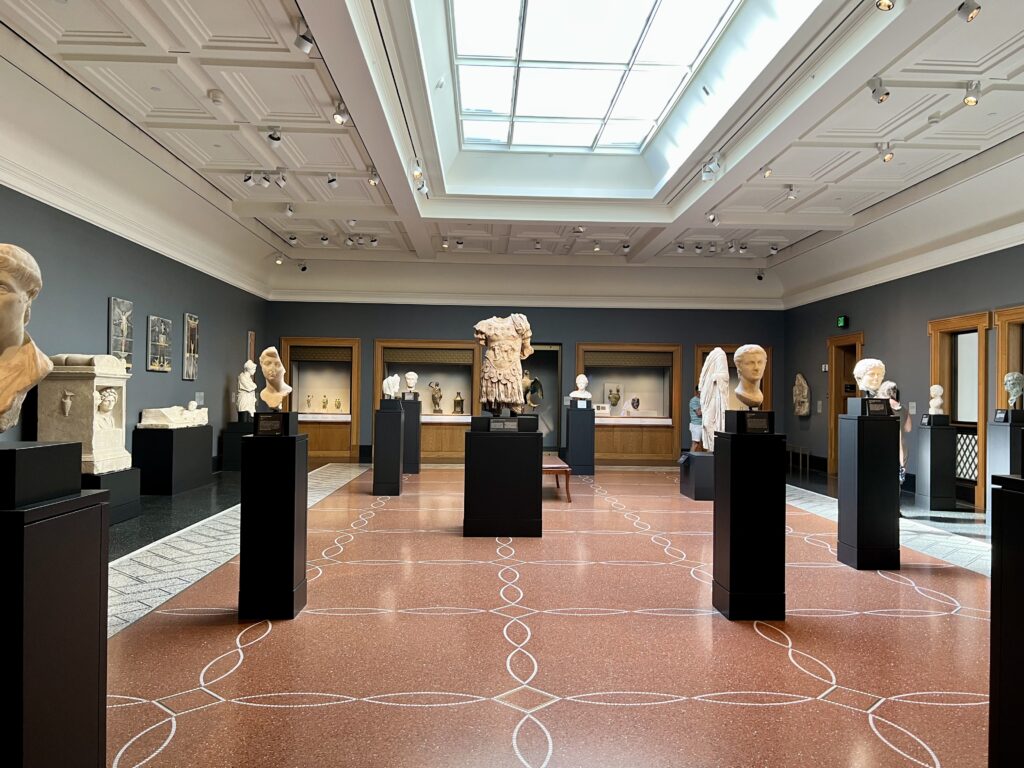
15. Galleries Of Early And Late Roman Sculpture
This Gallery of Early Roman Sculpture room features statues and busts from early Roman sculpture, including busts of the emperors. The greatest innovation over Greek sculpture was in portraiture.
Unlike the Greeks, Romans adopted a highly naturalistic style that didn’t idealize the sitter. They would show the subject’s age and rugged features. The sculptures were displayed in public places and used as propaganda.
In the center of the room is an elaborate Torso of a Man in Armor , who may be Emperor Tiberius. These type of statues honored victorious generals or members of the imperial family.
There’s also a statue is a 7 foot tall women draped in flowing drapery. It likely dates from 160-190 A.D.
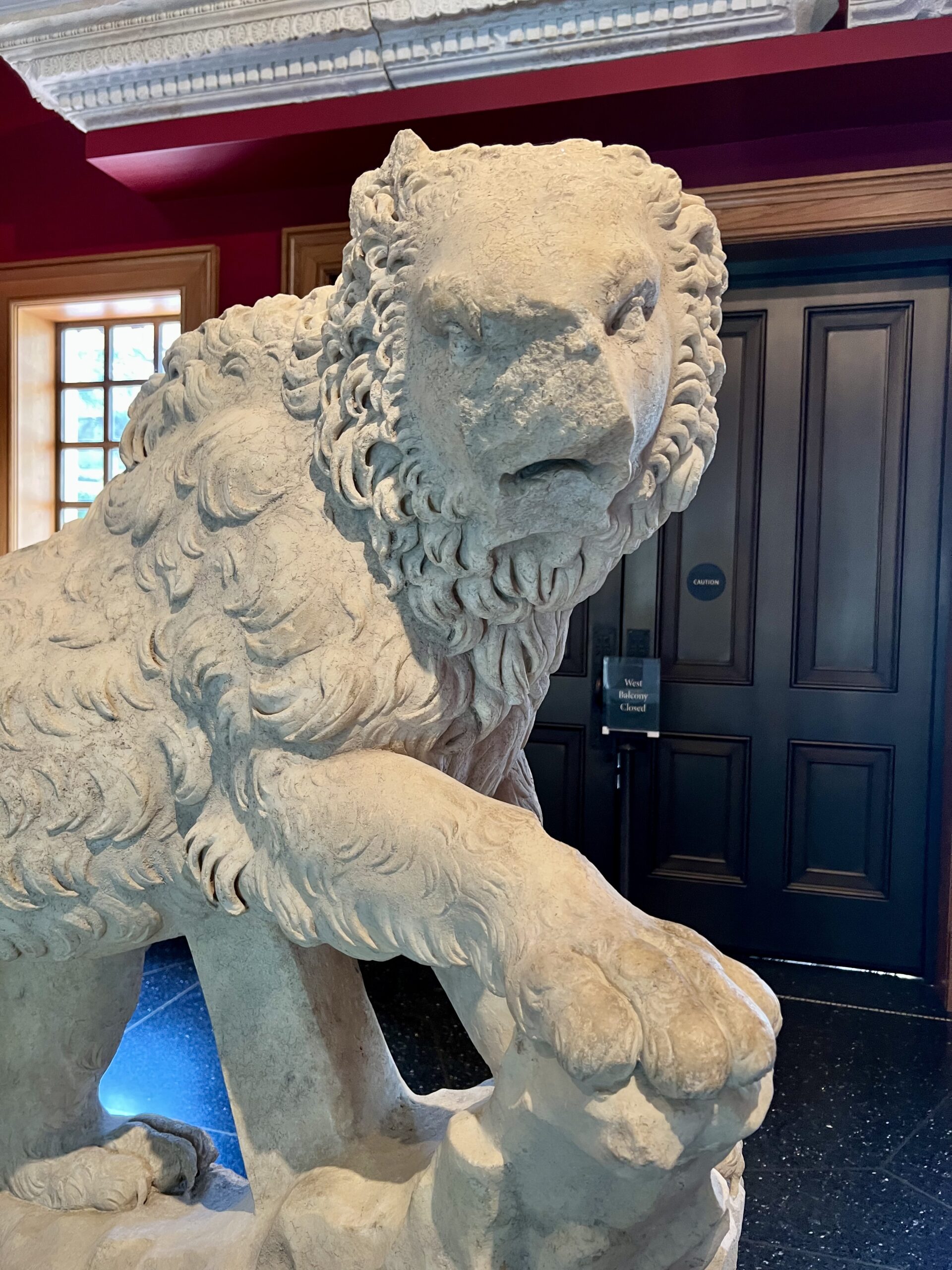
When the Getty Villa acquired the work in 1972, she was missing a head. But a senior curator of the Getty recognized the matching head on view in the Royal-Athena Gallery in New York and acquired it for the museum.
Another gallery on the second floor is dedicated to later Roman sculpture. There, you can inspect the Getty Commodus , a bust of Emperor Commodus.
The Getty acquired the bust in 1992 believing it was a late 16th century copy mimicking the Roman style. But today, most experts think it’s an ancient carving, dating from 180-185 A.D.
The bust is the fifth “type” of Commodus portrait and was likely created when Commodus became sole ruler after the death of his father Marcus Aurelius.
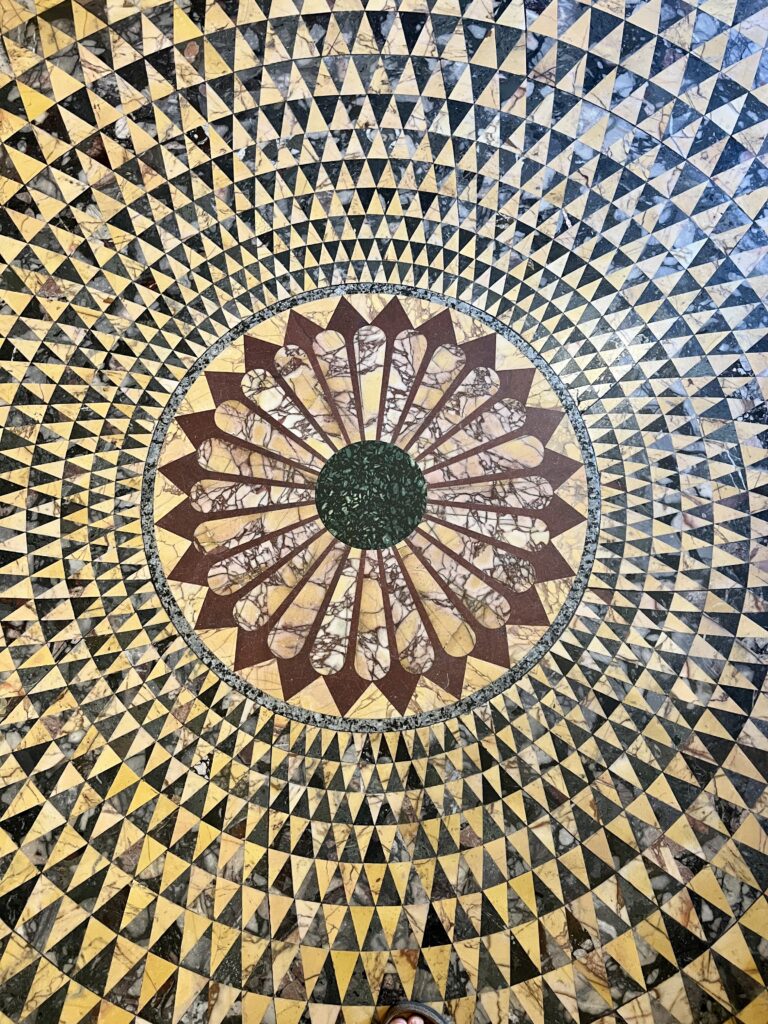
Guide To The Getty Villa: Tips For Visiting
Here are some must know tips for visiting the Getty Villa.
17985 E. Pacific Coast Highway, Pacific Palisades CA 90272.
You cannot make a left turn into the villa driveway, so try to approach from the south and keep your eye out for the sign and driveway.
2. Getting To The Getty Villa: Tickets & Parking
Tickets are free, except that you have to pay $20 for parking (or $15 after 3:00 pm). You can’t visit on a walk in basis and no street parking is available. Parking in the neighborhood is only by permit.
You can also take a taxi in. The attendant will direct you to the drop off center.
To visit, you need to make a timed entry reservation online . If you miss your reserved time, you may still be able to enter, if it’s off season or not busy.
Once you’re parked, walk up hill to the museum entrance.
If you are visiting both the Getty Villa and the nearby Getty Center on the same day, you only have to pay for parking once. Stop by the visitor center to get a parking pass for the Getty Center before leaving the Getty Villa.
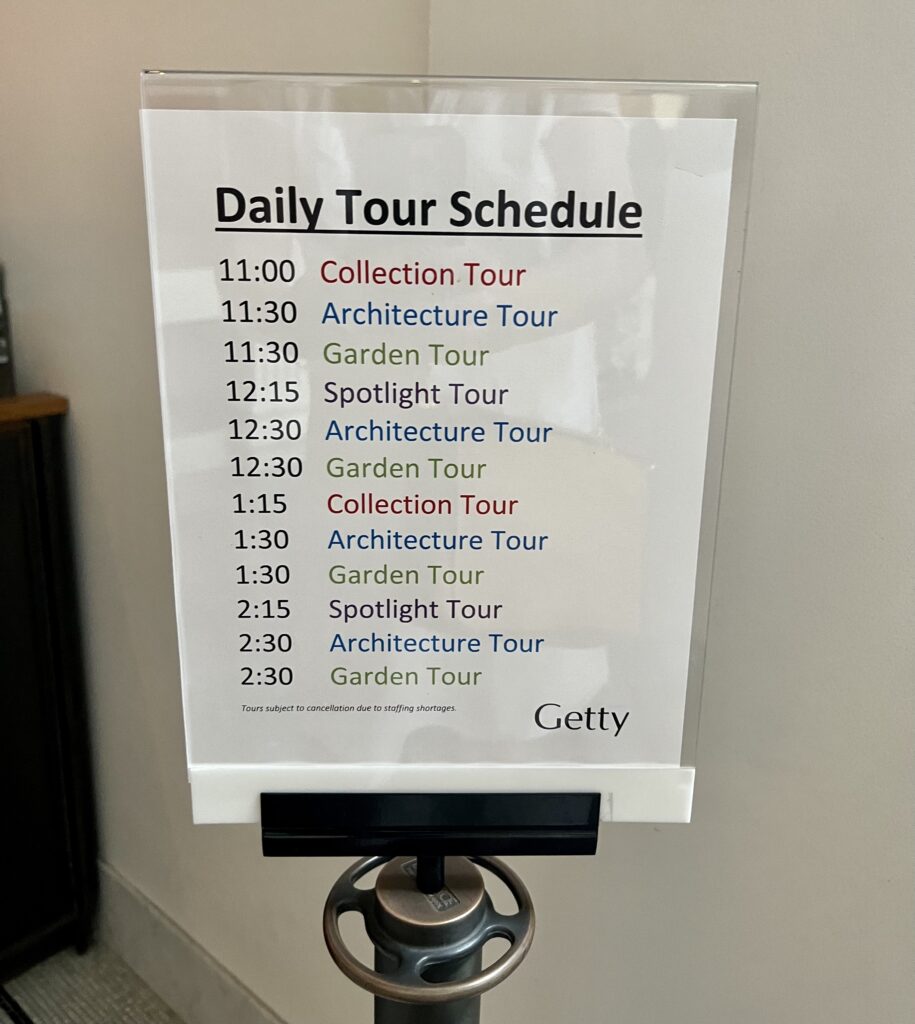
3. Collection Information & Tours
There is plenty of informational signage explaining the exhibits .You can also pick up an audio guide or download the Getty App .
You’ll need to leave your driver’s license or ID to pick up the audio guide. Punch in the number of the artifact you’re admiring to get information on it.
In addition, the Getty Villa offers quite a few themed tours that range from 20 to 45 minutes. The “highlights” tour is a free 50 minute tour of the museum’s greatest hits, which I recommend.
Click here to check out the tours. You need to sign up 15 minutes in advance and tours are limited to 10 per group.
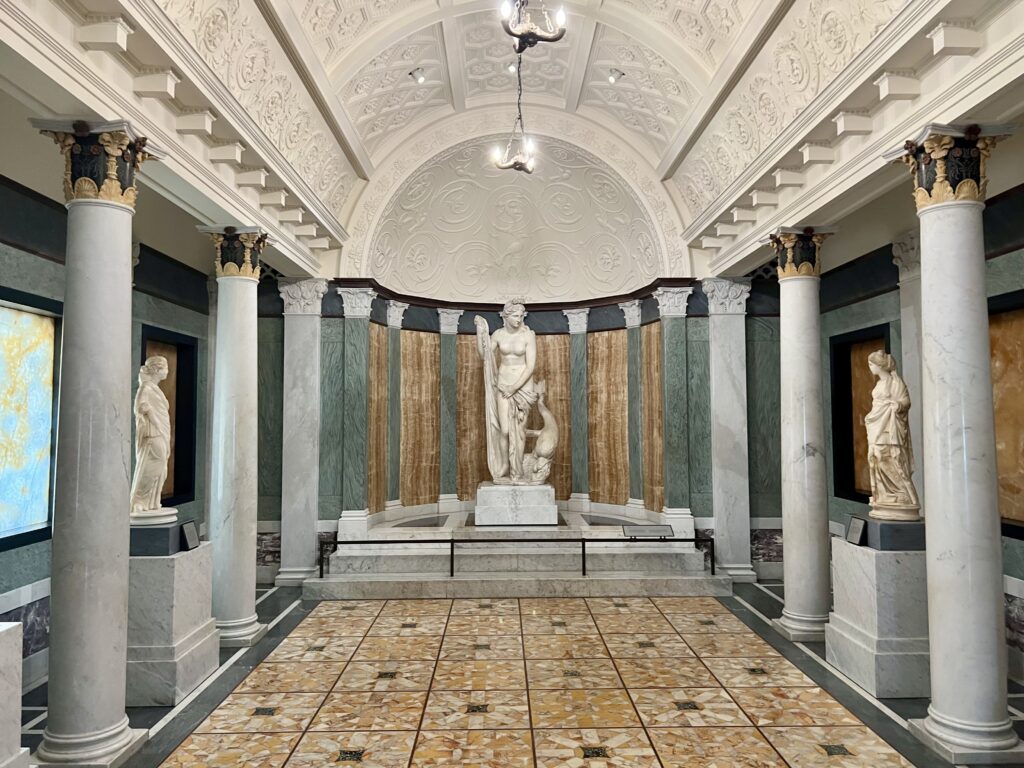
4. Museum Hours
The Getty Villa is open Wednesday through Monday from 10:00 am to 5:00 pm. It’s closed Tuesdays and on January 1, July 4, Thanksgiving, and December 25.
The best time to visit is around 3:00 pm. You’ll get the reduction in parking and have the museum largely to yourself.
5. How Long To Spend At The Getty Villa
The Getty Villa recommends you spend 60-90 minutes visiting. I was there 90 minutes and could definitely have stayed longer. So, if you’re iterested in Greco-Roman history, budget more time.
6. Cafes & Facilities
There’s also an onsite cafe, museum store, and outdoor Roman-style theater. You should hike up the steps of the theater for views down over the villa.
The cafe offers Mediterranean style food with indoor and outdoor seating. Near the cafe is the Espresso Cart for caffeinated beverages and pastries.
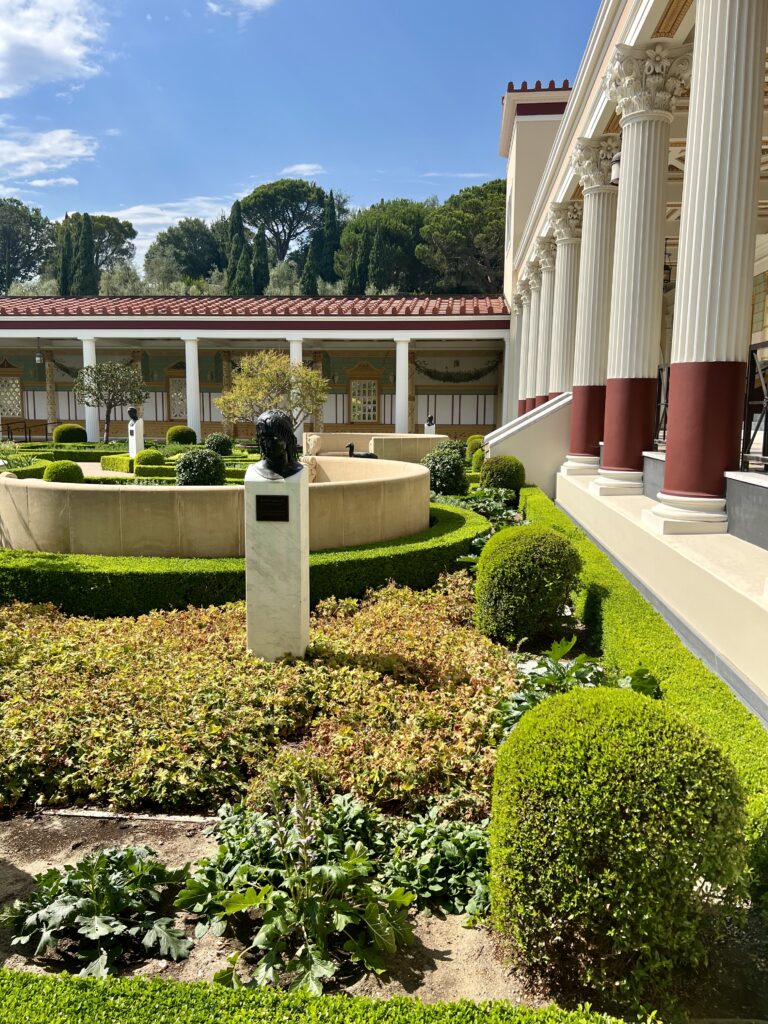
You can also have afternoon tea at the villa. The “Garden Tea” features a menu of sweet and savory flavors inspired by the villa’s Herb Garden. Reservations are required and you can make one on Open Table .
7. Getty Villa Theater
The villa has a Roman-style classical amphitheater near the entrance. The villa hosts concerts and versions of classic Greek and Roman dramas. Click here to check the schedule or purchase tickets.

8. Places To Visit Nearby
You can combine a visit to the Getty Villa with a visit to the Getty Center , Santa Monica, and Venice Beach.
The Getty Center is just 15-25 minutes away (depending on traffic) and makes a nice pairing with the villa. The center is a beautiful modern building designed by world famous architect Richard Meier.

It houses the rest of the Getty Collection. You can see Van Gogh’s Irises and a plethora of old masters from the Renaissance and Baroque periods.
The beach town of Santa Monica is just 15 minutes from the Getty Villa. You can relax on the golden sand beach, sample the pier attractions, and stroll the Third Street Promenade.
Venice Beach is on the south side of Santa Monica. You can walk the iconic boardwalk and enjoy the street performers.
For more information, check out my one day in Santa Monica itinerary .
I hope you’ve enjoyed my guide to visiting the Getty Villa. You may enjoy these other United States travel guides and resources:
- 2 days in Santa Barbara itinerary
- 1 day in La Jolla itinerary
- 2 days in San Diego Itinerary
- 3 day itinerary for Boston
- 1 day itinerary for Denver
- 2 day itinerary for Cleveland Ohio
- 10 day itinerary for New Hampshire
- 10 day itinerary for coastal Maine
- 7-10 day itinerary for Vermont
- 25 most beautiful towns in New England
- 45 amazing destinations in the United States
If you need a guide to the Getty Villa, pin it for later.
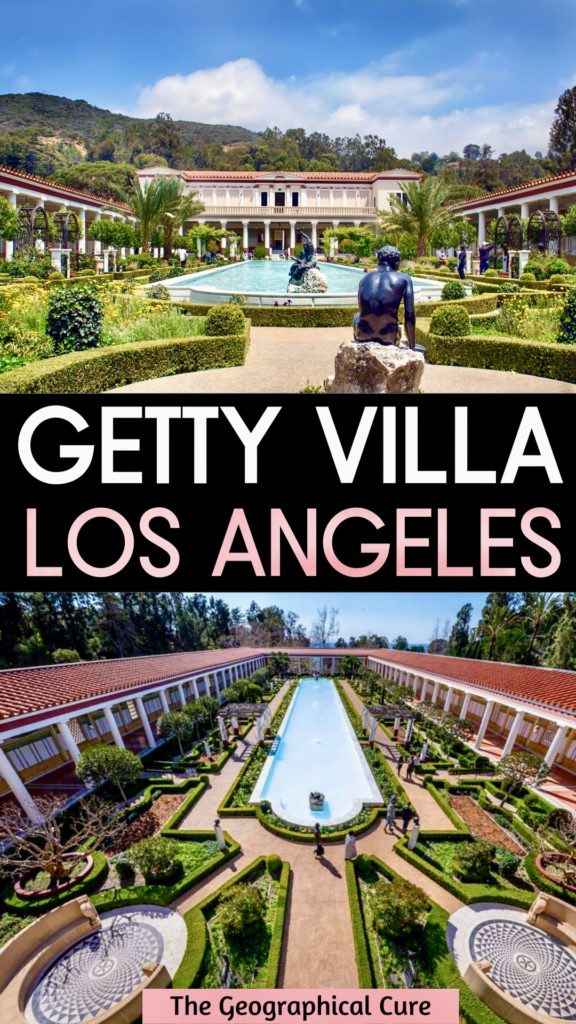
2 thoughts on “Guide To The Getty Villa In Los Angeles, What To See + Tips”
Absolutely amazing place. I was so intrigued. Leslie, your writing is an art in itself.interesting, colorful, informative and well done
Thank you so much!
Leave a Comment Cancel reply
Save my name, email, and website in this browser for the next time I comment.
Last Updated on August 31, 2023 by Leslie Livingston
The Getty Villa Museum: Antiquities on Display
:max_bytes(150000):strip_icc():format(webp)/betsy-hikey-1000x1500-56a386bf3df78cf7727ddc41.jpg)
TripSavvy / Christian Hundley
The Getty Villa
If you visit Los Angeles, you might be surprised to find that there are two Getty Museums in LA: the Getty Villa and the Getty Center.
Before you start planning, you should know what's where. If you're looking for the big museum with white buildings, sitting on top of a hill and designed by architect Richard Meier, that's the somewhere else. Use the Getty Center guide to find out how to visit it .
The Getty Villa in Malibu is the original museum started by J Paul Getty, filled with antiquities from Greece and Rome. It's very enjoyable if you like those things. If you aren't interested in the Roman architecture or the ancient art, it may not be the place for you.
TripSavvy / Christian Hundley
Things to Do at the Getty Villa
The museum complex includes a 450-seat outdoor classical theater, the villa, and a cafe.
You can go to the Getty Villa just to see their building. It's like stepping back a couple of thousand years into a Roman-style villa. To be precise, it's a reproduction of the Villa dei Papiri; a first-century Roman country house unearthed at Herculaneum which was buried when Mt. Vesuvius erupted in A.D. 79.
You can also go to see the villa's collection which is one of America's finest holdings of ancient Greek, Roman and Etruscan art. You'll see objects created over 7,000 years between the end of the Stone Age and the fall of the Roman Empire.
Besides the artwork, the Getty Villa stages performances that include re-imagined versions of classic Greek and Roman dramas, as well as new and adapted works inspired by the museum's holdings or the ancient world.
How to Plan Your Getty Villa Visit
Admission is free, but you need an advance, timed-entry ticket and they charge for parking.
The Villa is magically quiet shortly before the official opening time. Reserve the earliest entry time of the day, arrive a half hour or so before that to enjoy the grounds.
If you wait too late to reserve, you may find they are filled up. To avoid that, get your parking reservation as far ahead as you can on their website . At the last minute, you might get lucky. They sometimes release a few same-day tickets at 9:00 a.m. Check for them online or call 310-440-7300.
Tips for Visiting the Getty Villa
Take the orientation tours and weekend gallery tours to learn more about what you're seeing. Before plunging into the museum itself, look over the daily schedule of tours, gallery talks, and events, and plan your visit around them. Then sign up for them right away. Some tours will only take a limited number of people, and on others, they can run out of audio headsets.
Get more out of the museum with a GettyGuide. It's like getting a private tour with the museum's curators and conservators. You can pick up a multimedia player free of charge at the GettyGuide Desk just inside the main entrance.
Don't take big bags or packages. You'll just have to check them at the entrance. You'll also have to leave your umbrella in the cloakroom, but the museum provides plenty of them for you to use if you need them. And don't carry anything embarrassing. Your bags may be searched.
Got questions? Look for the people in white shirts and vests. They have answers.
The Cafe serves casual Mediterranean fare, which is quite tasty.
You can take photographs for personal use only, but no tripods or flashes are allowed. You can use your selfie stick, but only in public outdoor spaces. Child-carrying backpacks can't go into the galleries.
You can get their hours and more information on the Getty Villa website .
Driving to the Getty Villa
Most visitors arrive in a private vehicle. Vehicles over 6'10" high and standard car length/width aren't allowed, and there is no oversized vehicle lot.
The Getty Villa address is 17985 Pacific Coast Highway in Pacific Palisades, California. It's easy enough to put that address into your GPS, but if you overshoot the driveway entrance, you'll end up frustrated. So pay attention.
The only entrance is from the right lane of southbound Pacific Coast Highway. If you are driving north on PCH, you can't make a left turn into the entrance and will have to drive to Sunset Boulevard and make a u-turn.
The Getty Villa is less than a mile north of the intersection of Pacific Coast Highway and Sunset Boulevard. It's worth it to pay extreme attention for that entire mile. If you miss your turn, here's what to do but it will take a while: Continue south to Topanga Canyon Boulevard, turn back north there. Go all the way north to Sunset to make another u-turn.
On your way to the parking garage, you may wonder why the driveway is so rough. This place is so authentic that the road is paved with large stones similar to the ones found in the streets of ancient Herculaneum and Pompeii.
If someone is dropping you off, the entrance gate staff will direct you to the drop-off area. If you are using a ridesharing service, don't let the driver drop you off outside the entrance. If you walk in from there, they won't let you enter. They're not snooty, but just following the conditions of their permits.
Pay attention to where you park. After a few hours of museum-browsing, it's easy to forget where you started. Write the location down or take a photo.
Don't be lazy. Walk up the hill from the parking garage to the museum entrance if you can, to enjoy the gardens and views.
Other Ways to Get to the Getty Villa
No matter how hard you try to get around this, you can't walk into the Villa. The museum's permits forbid that.
The one exception is if you take Metro bus line 534, which stops at Pacific Coast Highway and Coastline Drive, directly across from the Getty Villa entrance. You will still need an advance, timed ticket and you will have to show your bus receipt or transfer at the gate.
The J. Paul Getty Museum at the Getty Villa
9 Museums You Can Visit for Free in Los Angeles
15 Los Angeles-Area Road Trips and Getaways
25 Best Free Things to Do in Los Angeles
J. Paul Getty Museum
Santa Monica and Venice Beach Gay Guide
Driving the Pacific Coast Highway in Malibu, California
25 Best Things to Do in Los Angeles
The 25 Best Things to Do in Los Angeles
Driving in Los Angeles
49-Mile Drive in San Francisco: What You Need to Know
Driving in New York City
Herculaneum: The Complete Guide
One Day Los Angeles Self-Driving Tour
Malibu: Planning Your Trip
Hotels in Los Angeles - Guide to Finding the Best Place to Stay

- Art + Photography
- Books + Websites
- Dance, Music + Theater
- Nature, Sports + Getaways
- Subscriber Offers
- High School
- Middle School
- Neighborhoods + Food
- People + Projects
- Top 10 Lists
The Getty Villa’s Top Ten Things to See and Do
- Destinations
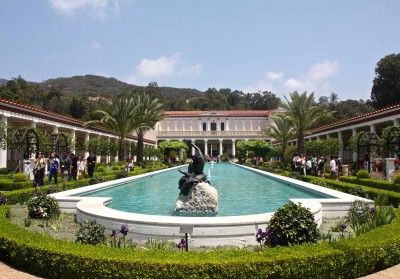
The Getty Villa lies halfway to Malibu atop a cliff, with magnificent views of the Pacific. The recreation of a Roman villa is filled with Greek, Roman and Etruscan antiquities. Parking should be reserved before a visit; be sure to allow yourselves time to explore the grounds and enjoy a delicious meal at the cafe. Visit the website for directions on parking reservations (easy to secure) and to time your visit in time for tours you might want to join. The Family Room has wonderful art activities for children and, like the Getty Center, the Art Detective Cards and audio tours are geared for kids.
1. Audio Tours: One of the best ways to get the most out of your visit to the Getty Villa is by renting out a free audio guide. They include in-depth information about the majority of art housed at the Villa, as well as a map of the grounds and history of the museum. Thematic Family Audio Tours are also available, with a focus on topics like gods, heroes, and athletes that cater to kids’ interests. Pick up your audio guide just beyond the information desk; you’ll see it after you make a right before the impulvium , or pool in the middle of the atrium.
2. Temple of Herakles: Keep heading clockwise through the rooms around the atrium until you reach the Temple of Herakles, known as the most important area to J. Paul Getty himself. The story of young Herakles is quite an impressive one, and is told in part by the marble sculpture itself. The victorious Herakles holds a lion skin in his right hand, as a trophy he acquired after killing the Lion of Nimea, which had been terrorizing a village. To get a more involved story of Herakles, continue in to the next room and read the panels on the far right hand wall.
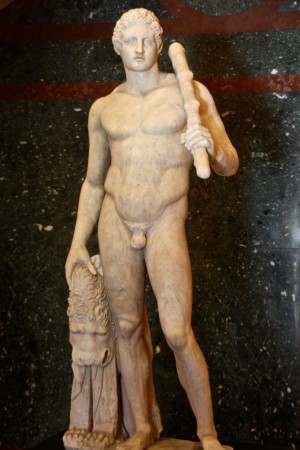
3. Family Forum: As you continue to make your way around the atrium, be sure to stop in the “Foro Familiar”. It’s the perfect spot for kids to apply the kinds of designs they find around the Villa. Your children can become part of a vase decoration themselves by donning some of the costume pieces provided and striking a pose behind a screen that dominates the room. If they prefer the fine arts to the performing arts, have them decorate a plastic vase with a dry-erase marker. Or, they can have fun making rubbings by placing a piece of paper over the designs etched into one of the tables, and (as the name suggests) rubbing a crayon over it.
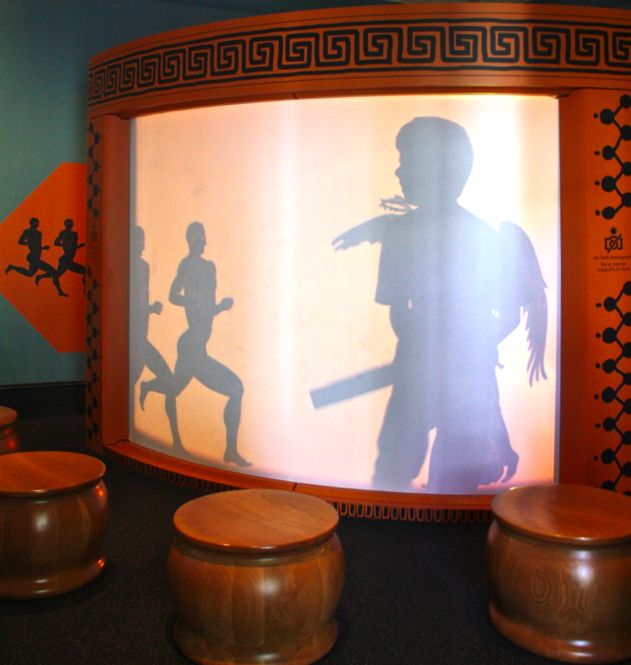
4. Reflecting Pool: Just beyond the Family Forum, this iconic pool dominates the Outer Peristyle and may be the highlight of your entire visit. The scene could have been taken directly from a painting, complete with sparkling blue water, blooming trees and flowers, and picturesque bronze sculptures dotting the landscape. Take your time—especially in this section of the museum—to walk around the entire perimeter and through the center to take in all the garden has to offer. If you’re feeling particularly relaxed, grab a bench and spend as much time as you please just taking in the scenery.The garden makes it wonderfully easy to forget about anything else you may have on your mind.

5. ArtQuest: The ArtQuest program at the Getty Villa provides a range of fun, educational, kid-friendly activities for you and your family to enjoy together. Activities differ per session, but always involve a craft table set up for hands-on learning. ArtQuest activities are held on Saturdays from 11:00 a.m. to 2:00 p.m.

6. The Café: If your tummy starts growling during your visit, head to the café located on the entrance level. It’s the perfect casual spot to satisfy your stomach with delicious Mediterranean-inspired cuisine, which complement the Villa’s architecture perfectly. Menu items are seasonal, and use plenty of fresh local ingredients. Offerings include dishes like a generous Mediterranean platter, salads, sandwiches, some pastas, special options for the bambini , and alcoholic beverages for parents. No reservations are required, but if you feel like having “Tea by the Sea” on a Thursday or Saturday at 1:00 p.m., making reservations is recommended.

7. Art Odyssey : On Saturdays from 11-11:30 a.m., the Villa gives you and your family the opportunity to explore the monsters, gods and goddesses, and famous heroes of antiquity in a more interactive fashion than your traditional museum tour. Led by a Villa educator, the Art Odyssey program incorporates fun family teamwork to create a very informative and educational museum experience. Be sure to sign up 15 minutes before the tour starts, and meet your group at the Tour Meeting Place.
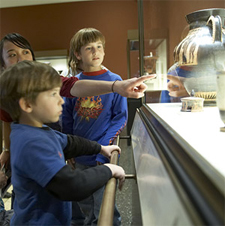
8. Barbara and Lawrence Fleischman Theatre: Outdoor views from the café look out on to the Villa’s gorgeous outdoor amphitheater. Classical dramas are performed here during the summer, and it is an excellent location to soak up some sunshine even when performances aren’t in progress.
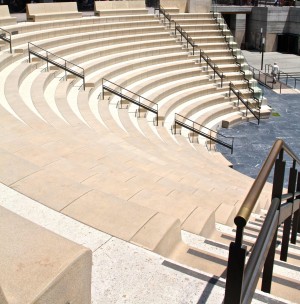
9. Auditorium: Just across from the store lies the Getty Villa’s indoor auditorium. Upon entering, you’ll be met by an impressive Roman mosaic floor portraying Medusa, which has now been mounted on the wall. The auditorium is the site for a variety of performances and lectures throughout the year, so be sure to check out the Villa’s event calendar before your trip to find out if there’s a performance in particular that might be of interest to your family.
10. Museum Store: At the bottom of the amphitheater and to the right is the merchandise hub of the Villa. Items include everything from fun postcards to fine jewelry and how-to children’s books. We were particularly fond of the “Build Your Own Kaleidoscope” handbook. If you don’t feel like splurging on some of the pricier publications, in-depth information on classical antiquity can also be found in the Reading Room, located on the upper level of the museum among the changing exhibitions.
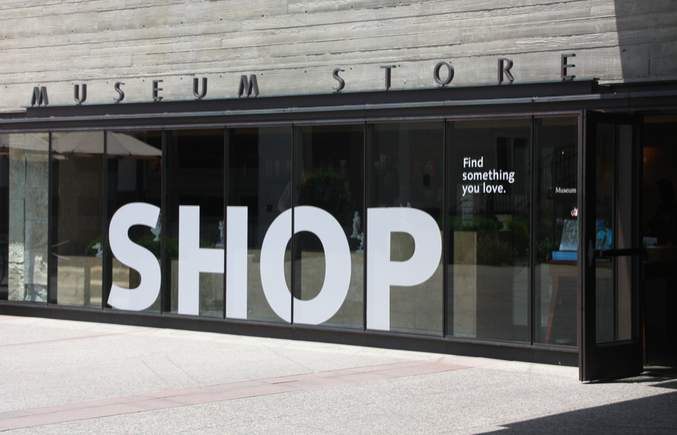
For Los Angeles
ALOUD The Library Foundation of Los Angeles LA Conservancy We Like LA KCRW – Design and Architecture KCRW – Press Play LA Observed Inside the Story the LAist Literary Affairs Los Angeles Magazine
For Parenting and Beyond
Common Sense Media NY Times Parenting NPR Parenting CoolMomPicks Red Tricycle
Cultural Curation
Brain Pickings Hyperallergic
Last Tweets
- Contact /Tips
- Terms and Conditions
- Privacy Policy
- Site by Lisa Hazen
© 2024 The Family Savvy. All rights reserved.
Catch every announcement and quiz!
Follow @readriordan on.
IMAGE CREDIT: @lolococonut on Instagram
Percy at the Getty Villa
The Getty Villa , a stunning museum in Malibu, California, is full of Greek and Roman art. And now they’re giving Percy Jackson fans the VIP treatment with a brand-new audio tour experience!
The Demigods, A Villa Audio Tour from the World of Percy Jackson , officially launched last Saturday with a party for Percy’s birthday. Fans cosplayed, ate blue cookies, and enjoyed a delightful performance by L.A.’s Troubadour Theater Company . See below for photos—and thanks to @lolococonut on Instagram for our banner image.

Troubadours Cloie Wyatt Taylor as Solus, Goddess of Safety, and Henry Phillips on guitar.

Troubadour Jennifer Cannon as Medusa.
If you find yourself in the Los Angeles area, make your way to the Villa and take the tour for yourself. Or you can listen at the Getty’s website here .

Read Riordan
- Terms of Use
- Additional Content Information
- Privacy Policy
- Your US State Privacy Rights
- Children’s Online Privacy
- Interest-Based Ads
- Do Not Sell My Personal Information,
- facebook-rs
My Morning Jacket, Nathaniel Rateliff and the Night Sweats Team for Co-Headlining Tour
By Althea Legaspi
Althea Legaspi
My Morning Jacket and Nathaniel Rateliff and the Night Sweats have teamed up for a co-headlining tour that runs through September. Dubbed the Eye to Eye Tour, the bands will perform equal-length sets and switch the order of their performances with each show.
Tickets go on sale this Friday, March 29, at 10 a.m. local time, with presale tickets available beginning March 26 at 10 a.m. local time. More information is available on the official tour website.
“We were lucky enough to see Nathaniel and some of the Night Sweats at Preservation Hall in New Orleans some years ago — our minds were blown, our hearts were opened, and we got swept up in the joy of it all,” My Morning Jacket’s Jim James said in a statement. “We are so happy to share the stage with these fine folks for a run full of peace, love, music, and fun!”
Eric Trump Says Lenders He Hit for Half-Billion Dollars in Father's Bond Scramble 'Were Laughing'
Fergie chambers is heir to one of america’s richest families — and determined to see the u.s. fall, 'the death of college sports will be fast and furious:' the scandal that could kill the ncaa, sean combs' homes raided as part of 'sex trafficking' investigation.
My Morning Jacket released their most recent self-titled album , the band’s ninth studio LP, in 2021. That same year, Nathaniel Rateliff and the Night Sweats dropped their third studio album, The Future .
Eye to Eye Tour Dates Sept. 10 – Wilmington, NC @ Live Oak Bank Pavilion at Riverfront Park Sept. 12 – Charleston, SC @ Credit One Stadium Sept. 13 – Charlotte, NC @ PNC Music Pavilion Sept. 14 – Alpharetta, GA @ Ameris Bank Amphitheatre Sept. 16 – Jacksonville, FL @ Daily’s Place Sept. 18 – Nashville, TN @ Ascend Amphitheater Sept. 19 – Nashville, TN @ Ascend Amphitheater Sept. 24 – Syracuse, NY @ Empower Federal Credit Union Amphitheater at Lakeview Sept. 26 – Philadelphia, PA @ TD Pavilion at the Mann Sept. 27 – Columbia, MD @ Merriweather Post Pavilion Sept. 28 – Raleigh, NC @ Coastal Credit Union Music Park
Bruce Springsteen and the E Street Band Are Playing on the Beach in Asbury Park. Here's How It Happened
- By Brian Hiatt
A Brief Look at Diddy's History of Controversies and Allegations
- History Rhymes
- By Andre Gee
Sean Combs' Homes Raided as Part of 'Sex Trafficking' Investigation
- By Cheyenne Roundtree and Nancy Dillon
'Kidz Bop' Could Never: Watch a Bunch of Children Cover Nine Inch Nails' Self-Loathing Anthem 'Wish'
- Fist... Bump?
- By Jon Blistein
Adrianne Lenker Offers a Candid Image of Hopefulness and Heartbreak on 'Bright Future'
- ALBUM REVIEW
Most Popular
James marsden, taran killam and stars who signed brian peck letters of support "devastated" drake bell, says dan schneider, blake lively apologizes for mocking kate middleton 'photoshop fails' after princess reveals cancer diagnosis: 'silly post' has 'me mortified', body language experts believe this is the reason kate middleton was alone in her cancer announcement video, james madison’s record $53m in student fees tops all public schools, you might also like, seth rogen’s apple tv+ comedy ‘the studio’ casts catherine o’hara, kathryn hahn, bryan cranston and more, new book ‘audrey hepburn in paris’ tells the story of her style evolution & more, the best yoga blocks to support any practice, according to instructors, hot docs exodus: artistic director exits and 10 programmers resign, a month before 2024 festival, shohei ohtani denies knowledge of interpreter’s gambling.
Rolling Stone is a part of Penske Media Corporation. © 2024 Rolling Stone, LLC. All rights reserved.
Verify it's you
Please log in.
- International tour dates
- North American tour dates
- How to buy tickets
- How much are tickets?
Need travel arrangements?
- Who is opening?
- Will there be more tour dates?
- Where can I stream the film?
How to buy Taylor Swift tickets: Eras Tour dates and prices compared
When you buy through our links, Business Insider may earn an affiliate commission. Learn more
Taylor Swift's reign continues as she ramps up for the next leg of The Eras Tour. The singer-songwriter will kick off the European portion of her world tour in Paris in May, which will continue throughout the summer. From there, she'll return to North America to tour Canada and a few remaining US cities in the fall. If you're hoping to attend, we've compiled all of the details of The Eras Tour, including how to get Taylor Swift tour tickets.
Swift's Eras Tour has taken the world by storm since March 2023. The three-plus-hour tour features hits from each of Swift's album eras, from "Lover" to her recent Grammy Award-winning "Midnights." Each show also features surprise songs and occasional guests, so fans never quite know what they're in for. Swift will release her latest album, "The Tortured Poets Department," in April, but it's unknown if any of those songs will make their way to the tour setlist.
- See also: Adele tickets | Olivia Rodrigo tickets | Bad Bunny tickets | Bruce Springsteen tickets | Drake tickets | Stevie Nicks tickets
Getting tickets has become its own battle and many fans have waited hours in the Ticketmaster queue to hopefully snag some seats, if they could get a presale ticket code in the first place. While Swift continues to extend the tour, including new US dates, tickets remain hard to come by.
Below, we've put together a guide on everything to know about The Eras Tour, including the tour schedule, ticket purchasing details, resale ticket prices, and the concert film streaming options . You can also peruse resale vendors like StubHub and Vivid Seats at your leisure.
Taylor Swift international tour dates
The Eras Tour international dates resume on May 9 in Paris. The European tour will run until August 20 in London. UK prices are listed in pounds, and start times vary from city to city. US dates start in October and can be found under the following table.
Taylor Swift North American tour dates
The Eras tour will return to the US on October 18 in Miami. In addition to the Miami shows, Swift will perform multiple dates in New Orleans and Indianapolis. On November 14, Swift will head to Canada for several shows in Toronto and Vancouver. All North American shows start at 7 p.m. local time.
How to buy tickets for Taylor Swift's 2024 tour
Original standard tickets for Taylor Swift's 2024 sold out long ago for both international and domestic dates. All US tickets and many international tickets were sold through Ticketmaster , although select international locations used different services.
Tickets for most dates are available on resale websites like StubHub and Vivid Seats . These are generally higher-priced than the originals, which are no longer available. Keep in mind that some countries have rules regarding reselling tickets.
How much are Taylor Swift tickets?
Ticket prices vary by date and location. International resale tickets tend to be a bit cheaper than US resale tickets. It's worth noting that some of the cheapest tickets have restricted views.
StubHub's cheapest European tickets range from $392 (Madrid, Spain, on May 29) to £978 (London, United Kingdom, on June 22). The latter is around $1,248 in USD. The lowest prices for most shows are around $450 to $1,000. On Vivid Seats , the cheapest tickets for these dates go for $549 and $683, respectively.
When it comes to North American shows, the cheapest StubHub tickets range from $1,045 (Vancouver, Canada, on December 8) to $2,081 (Miami, Florida, on October 19). Most of the cheapest tickets are priced between $1,200 and $1,800. On Vivid Seats, the cheapest Taylor Swift tickets on these dates start at $1,133 and $2,212, respectively. The two resale vendors generally have similarly priced offerings, but this varies from show to show.
- Flights & hotel: Booking.com | Expedia | CheapOAir
- Flights: Booking.com | Expedia | Tripadvisor | Skyscanner | CheapOAir
- Accommodation: Booking.com | Expedia | Airbnb | Tripadvisor | SkyScanner | CheapOAir
- Parking: Spot Hero | The Parking Spot
Who is opening for Taylor Swift's tour?
Taylor Swift has a variety of opening acts, from up-and-coming singers to established groups. Opening acts vary by date. For the European leg of the tour, Paramore will open for Swift. In the US and Canada, Gracie Abrams will be the opening act.
Will Taylor Swift add more dates to the Eras Tour?
Taylor Swift already added additional stops to her tour due to popular demand, including her US tour dates this fall. She also added additional dates to some of her European city stops, including bonus performances in France and the United Kingdom, among other locations. It's unknown whether Swift will end up adding even more tour dates, but by the end of the upcoming US leg she will have been touring for almost two years, so fans shouldn't be surprised if she takes a break.
Where can I stream The Eras Tour concert film?
If you'd rather watch The Eras Tour from home, you could always stream it on Disney+. Check out everything you need to know about streaming The Eras Tour concert film in our guide .
Note: Certain services and regions prohibit the resale of tickets. Business Insider does not endorse or condone the illegal reselling of tickets, and entry into an event is at the venue's discretion.
You can purchase logo and accolade licensing to this story here . Disclosure: Written and researched by the Insider Reviews team. We highlight products and services you might find interesting. If you buy them, we may get a small share of the revenue from the sale from our partners. We may receive products free of charge from manufacturers to test. This does not drive our decision as to whether or not a product is featured or recommended. We operate independently from our advertising team. We welcome your feedback. Email us at [email protected] .

- Main content
17 Best Moscow Tours

Are you planning a visit to the capital of Russia and looking for the best Moscow tours? From Red Square to the Kremlin and from world-class art to fairytale buildings, Moscow is an enchanting city that offers plenty of excitement and elegance. Its history dates back more than 800 years, and there is culture in abundance for visitors to immerse themselves in.
Make the most of your visit with 17 of the best Moscow tours that let you see everything the city and its surroundings have to offer.
1 – Guided Tour of the Moscow Metro
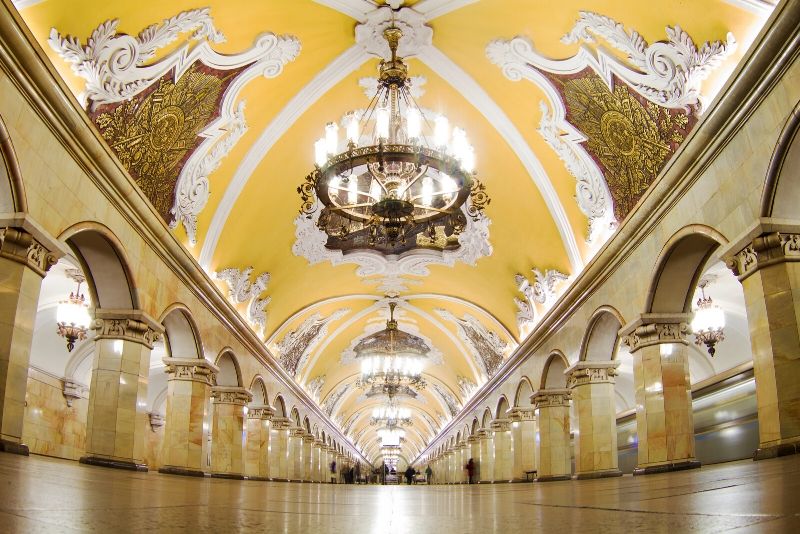
Moscow’s metro is world-famous, thanks to the architectural delights on offer underground stations around the capital. This guided tour of the Moscow stations, otherwise known as “the palace of the people” lasts for 1.5 hours and includes an English-speaking guide who will tell you how the Russian metro became one of the most beautiful in the world. Highlights include Mayakovskaya station with its aviation-themed mosaics.
- Moscow metro tours
2 – Cosmonautics Museum Space Tour
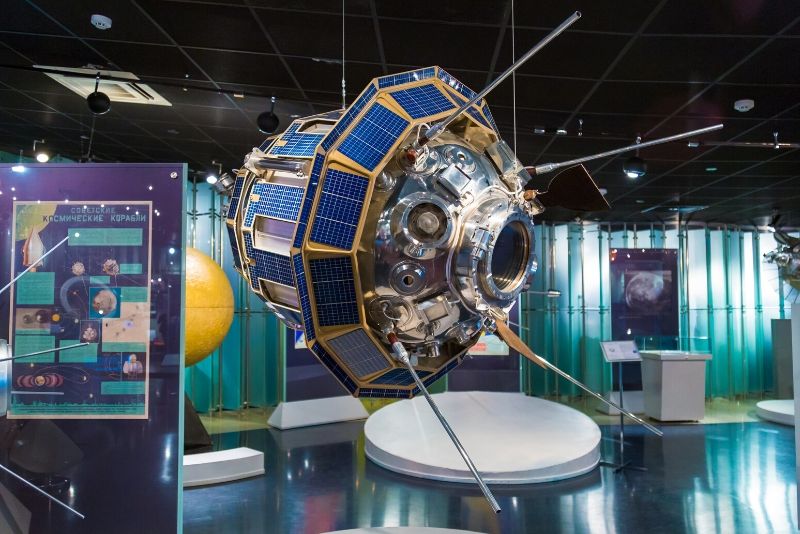
Discover Cosmonautics Museum with this space tour. Dive into one of the greatest battles between the Soviet Union and the United States – the space race. Hear about the space programs of the USSR and learn about how the USSR shaped space travel and technology.
- Cosmonautics Museum tours
3 – Guided Tour of the Kremlin

A Kremlin is actually a citadel in Russian towns, and Moscow’s version is, without doubt, the most famous. The Kremlin is the heartbeat of the city, and this guided tour takes you to the most important points of interest. See Cathedral Square with its orthodox temples; Tzar Cannon with its 890mm calibre, which is the largest in the world; and the exterior of the all-important government buildings that are located within the Kremlin’s walls.
Click here to learn how to book Kremlin tickets .
- Kremlin tours
4 – Moscow City Walking Tour

One of the best Moscow tours for seeing everything the city has to offer, this small-group walking tour lasts for 2 hours and includes an expert guide. Make the most of the capital and see the cobbled spaces of Red Square, take pictures of St Basil’s Cathedral, visit the elegant Bolshoi Theatre, and enjoy the ornamental Alexandrovsky Garden.
- Moscow walking tours
5 – Night Tour of Moscow

When the sun sets, the fun begins – and it all starts with a night tour of Russia’s most famous city. The beauty of Moscow comes into full effect after hours, as iconic buildings like St Basil’s Cathedral illuminate against the night sky. Other locations on this tour include the Moscow River and the Ukraine Hotel, which is a landmark skyscraper that was constructed during the era of Stalin.
6 – Sergiev Posad Day Trip

One of the best Moscow tours that take you outside of the city, the Sergiev Posad day trip provides the opportunity to see The Trinity Lavra of St. Sergius, a UNESCO World Heritage Site that is the spiritual centre of the Russian Orthodox Church. It’s made up of a number of different buildings that include the blue domes of the Cathedral of the Assumption, Church of St. Sergius and the Bell Tower.
- Sergiev Posad day trips from Moscow
7 – City Sightseeing Moscow Hop-On Hop-Off Bus Tour with Optional Cruise

If your time in Moscow is limited, this hop-on, hop-off bus tour is ideal – and it even features an optional cruise on the river. Choose between a 2 and 3-day ticket and see famous landmarks like Red Square, the Kremlin and the Bolshoi Theatre from an open-top panoramic bus with informative audio commentary. Take your experience to the next level by upgrading to a boat tour.
- Moscow hop on hop off bus tours
8 – Guided Tour of the Tretyakov Gallery
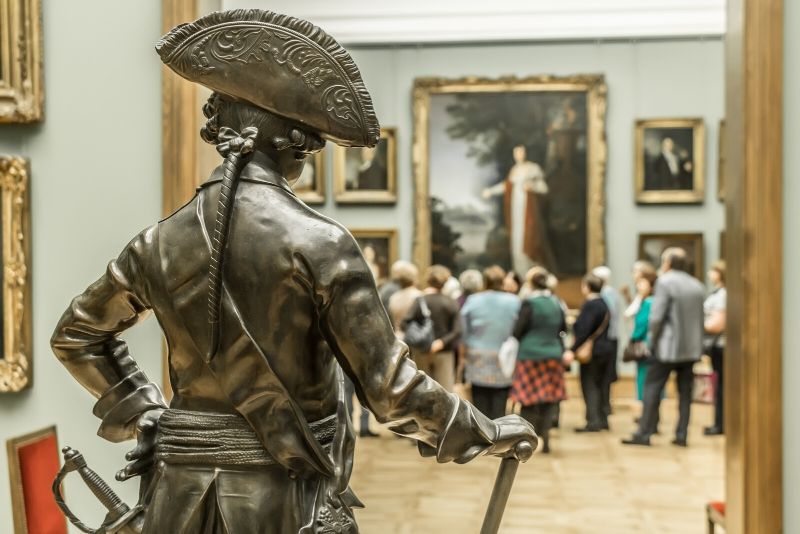
As one of the world’s most important galleries, the Tretyakov Gallery is a must-see for any art lovers and is one of the best Moscow tours for culture vultures. Learn about the masterworks of Pablo Tretyakov with a guided tour and discover the secrets behind the paintings. Other noticeable artists on view include Fedotov, Vasnetsov, Rokotov and Kiprenski, who is the author of the famous “Portrait of Alexander Pushkin”.
- Tretyakov Gallery tours
9 – Alternative Moscow: 2-Hour Walking Tour

See a different side of Moscow with this 2-hour alternative tour. An expert guide will take you around quirky streets, suburbs and squares while as your veer away from the traditional tourist hotspots. Highlights include a ride on the famous “Annushka” tram and a visit to the neighbourhood of Khitrovka, which was once known as the criminal district of the city.
10 – St.Basil’s Cathedral and Red Square: Private Tour and Ticket

Combine two of Moscow’s biggest attractions with a visit to Red Square and St.Basil’s Cathedral. Admire the beautiful architecture of St.Basil’s Cathedral from inside and out, before wandering Red Square and learn about the soldiers, farmers and revolutionaries that all called this famous square their home. Round things off with the changing of the guard at Alexander Garden.
- Red Square tours
11 – Bunker-42 Cold War Museum Guided Tour
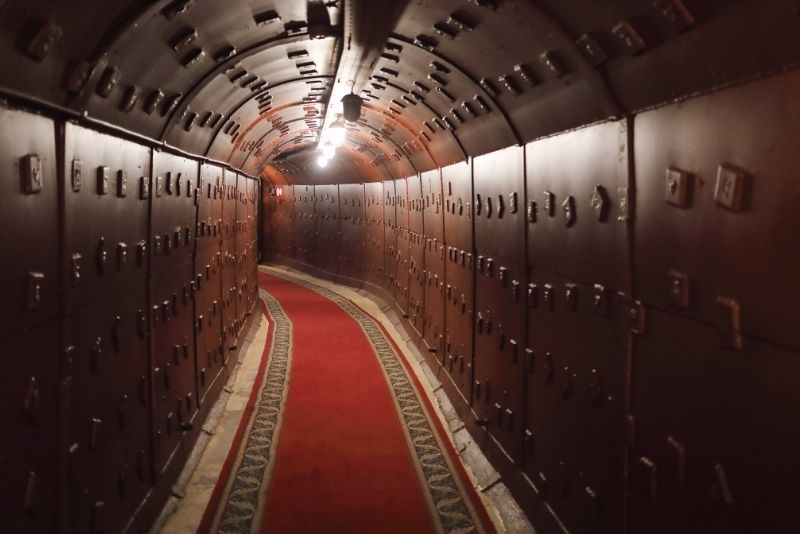
Moscow is notorious for the Cold War, which lasted for about 45 years between 1945 and 1990. Head to the world-famous Bunker-42, located 65 meters below ground level, and learn about the storied past. Visit rooms and passages that were set up to shelter 3,000 people in case of nuclear attack and discover other sections, such as the equipment room and the war-proof telecommunications system.
- Bunker-42 Cold War Museum tours
12 – Architecture Tour of Moscow’s Metro and Kolomenskoye Estate

Combine the beauty of the metro stations with the Kolomenskoye Estate and see some of Moscow’s grandest sights. After visiting the elegant metro stations, it’s time to go to the Kolomenskoye Estate, which is filled with UNESCO-listed sites that are dedicated to Tsar Peter the Great.
- Kolomenskoye tours
13 – Tour of Soviet Moscow

Unpick the history of the USSR with one of the best Moscow tours for discovering Soviet Moscow. Starting at Monument to the Conquerors of Space, a tribute to the success of the Soviet space programme, the tour includes historical landmarks and interesting tidbits about Soviet Russia. There is also a visit to the All-Russia Exhibition Centre (VDNKh), a site that was constructed under the aegis of the USSR in tribute to state achievements.
14 – Moscow: 2.5-Hour Luxury River Cruise with Dining Option

Sail down the Moscow River on this 2.5 hour tour that provides a different perspective of the city and includes landmark sights. The boat features two decks and has panoramic views as well as free Wi-Fi access. Attractions along the route include Ukraine hotel, Sparrow Hills, Christ the Saviour Cathedral, Crimean Bridge, St. Basil’s Cathedral, Zaryadye Park and more.
- Moscow boat tours
15 – Izmailovo Market and Vodka Museum Tour

Visit the museum of Vodka and gain insight into one of Russia’s most famous exports and head to the Izmailovo antique and handicraft market to find a gem or two. The tour starts with Izmailovo market, which features the iconic matryoshka dolls, fur hats and amber jewellery. Next up is a trip to the Museum of Vodka, where you will discover a distillery that dates back to the 15th century.
- Izmailovo market tours
16 – Súzdal and Vladímir Day Tour

Discover Russia’s famous “Golden Ring” on this tour of two medieval cities outside of Moscow. The historic city of Vladimir is first up with its Golden Gate, which is an ancient city-fortress that dates back to the 13th century. Next up is the neighbouring town of Suzdal, which features historic architecture and the Kremlin, where you can see its striking white walls topped with blue domes.
- Suzdal & Vladimir tours from Moscow
17- Moscow Food Tasting & Walking Tour

Sample the unique flavours of Moscow with this food tour that lasts for 3 hours and features more than 15 different food and drink tastings. Weave in and out of small alleys in the city centre while enjoying the best food spots in town. See Moscow like a local while trying classic dishes from local breakfast haunts, bustling markets, the oldest monastery in Moscow, and dumpling cafes where you can taste authentic dumplings and enjoy local coffee.
- Moscow food tours
- Skip to main content
- Keyboard shortcuts for audio player
Consider This from NPR

- LISTEN & FOLLOW
- Apple Podcasts
- Google Podcasts
- Amazon Music
Your support helps make our show possible and unlocks access to our sponsor-free feed.
Can America Win The Chips Manufacturing Race?

Intel CEO Pat Gelsinger (L) and Intel Factory Manager Hugh Green (R) watch as US President Joe Biden (C) looks at a semiconductor wafer during a tour at Intel Ocotillo Campus in Chandler, Arizona, this week. The White House unveiled almost $20 billion in new grants and loans Wednesday to support Intel's US chip-making facilities. BRENDAN SMIALOWSKI/AFP via Getty Images hide caption
Intel CEO Pat Gelsinger (L) and Intel Factory Manager Hugh Green (R) watch as US President Joe Biden (C) looks at a semiconductor wafer during a tour at Intel Ocotillo Campus in Chandler, Arizona, this week. The White House unveiled almost $20 billion in new grants and loans Wednesday to support Intel's US chip-making facilities.
President Biden just awarded $8.5 billion dollars to the company Intel to help fund semiconductor factories in Arizona, Ohio, New Mexico, and Oregon. At a visit to Intel's campus outside Phoenix this week, President Biden said the money will help semiconductor manufacturing make a comeback in the US after 40 years. The money for Intel comes from the $ 9 billion set aside by the 2022 CHIPS and Science Act, to build chip factories. The administration's goal? For 20% of the world's leading-edge semiconductor chips to be made on American soil by 2030. The US currently makes zero of the world's leading-edge semiconductor chips. By 2030, the Biden administration wants to make A FIFTH of them. So how will America get there? For sponsor-free episodes of Consider This , sign up for Consider This+ via Apple Podcasts or at plus.npr.org . Email us at [email protected] .
This episode was produced by Jonaki Mehta and Erika Ryan with audio engineering by Kwesi Lee. It was edited by Courtney Dorning and Christopher Intagliata. Our executive producer is Sami Yenigun.

- Buenos Aires
- Paris Christmas Light
- Thessaloniki
- Kuala Lumpur
- Mexico City
- Kristiansand
- Panama City
- St. Petersburg
- Johannesburg
- Benalmadena
- Gran Canaria
- Palma de Mallorca
- San Sebastian
- Bournemouth
- Derry-Londonderry
- London Christmas Light
- Stratford-upon-Avon
- Los Angeles
- New Orleans
- Philadelphia
- San Antonio
- San Francisco
- St. Augustine
- Trolley Tour
- Washington D.C.
- Ho Chi Minh
- GBP (£) USD ($) AUD ($) HKD ($) ZAR (R) CNY (¥) NOK (kr) CZK (Kč) GBP (£) CAD ($) AED (د.إ) CHF (₣) ISK (kr) SEK (kr) DKK (kr) EUR (€) SGD ($) INR (₹) NZD ($) MXN ($) THB (฿) MYR (RM)
- 🛒 0
- Login / Sign Up
Hop On Hop Off in Moscow

City Sightseeing: Moscow Hop-On, Hop-Off Bus Tour
- The Bus Tour offers unlimited 360° panoramic views of main sights of Moscow.
- Access to audio-guide in 10 different languages which enables to know about Moscow’s history and traditions.
- The three-bus tour routes and 40+ stops around Moscow completes the trip. Draw an itinerary to explore the city on your own.
- There can be a boat tour and bus tour to enjoy panoramic views of Moskva River.
- Smartphone Voucher Accepted. (No need to print)
- 24 / 48-Hours Hop-on Hop-off Bus Ticket
- Red Line Audio Guide: Russian, English, German, Spanish, Italian, French, Chinese, Arabic, Portuguese, Farsi
- Green Line Audio Guide: Russian, English, German, Spanish, Italian, French, Chinese, Arabic
- Orange Line Audio Guide : Russian English, German, Spanish, Italian, French
- Guided walking tour
- Boat Tour (If option selected)
- Red Route: Schedule: 10:00 - 18:00 , Loop: 60 Minutes, Frequency: 15 Minutes
- Green Route: Schedule: 10:00 - 18:00 , Loop: 120 Minutes, Frequency: 30 Minutes
- Orange Route: Schedule: 10:00 - 18:30 , Loop: 140 Minutes, Frequency: 30 Minutes
Wheelchair Access, Heating Please note that face masks must be worn on board the bus. Orange Route is temporarily suspended
Operational Details: Walking Tour
- Daily at 10:45 a.m.
- Duration: 2 hours 30 minutes
- Meeting point: next to the monument to Saints Cyril and Methodius (Kitay-Gorod metro station)
Capital River Boat Tour
- May - October: from 11:30am to 6:30pm (Subject to change)
- Duration: 60 minutes
- Departure Point: Zaryadye Park Pier
No Cancellation Charges up to 24 hours before the chosen travel date. 100% cancellation fee applied within 24 hours of travel date.
Hop On Hop Off Moscow Bus Tours
Moscow, the capital of Russia, is the largest and the most populous city in the country. Present on the banks of the Moskva river, this city serves as the cosmopolitan hub of the country. Carrying 871 year old rich history, this city has played an integral part of Russia’s development and therefore plays an integral role in all the aspect. Majority of the population of Russia lives in Moscow, and the city is responsible as the scientific, historical, political and architectural hub in the region. Moscow is a blend of the old and new Russian culture. The Kremlin complex in the center of the city holds the cultural and historical values of the city. Moscow was also the capital and most important part of the USSR and thus holds many gems throughout the city from that era. Not only that, but the city also brags of timeless elements from the Tsars and other rulers who ever ruled Russia. Moscow has been a hub of many social ideologies and home to popular poets and artists. When in Moscow don’t miss out The Moscow Kremlin, the colorful St. Basil’s Cathedral, the symbolic center of Russia as the Red Square and Lenin's Mausoleum, which also serves as the resting place of Vladimir Lenin and his body has been preserved there since 1924.
Other Cities in Russia
Password reset successful. We've sent the new password to your registered email. Please check your email for the confirmation.
Sorry, it looks like this email isn't registered.
For groups of 12 or more, you may send us an inquiry at [email protected]. Although we do not guarantee bulk deals for all our tours, there are some tours for which we can offer discounted pricing. Ordinary hop-on-hop-off bus tickets are entitled to group savings. Attractions, pass items and combo tickets aren't.
Due the nature of this type of tour and varying demand, group travellers should be aware that there is no guarantee that the group will be able to travel altogether as the available seats vary from stop to stop and depends on demand each day. The group may need to split up and/or wait for the next bus(s).
As, we cannot guarantee that the group shall be able to travel together as one group, therefore we will reduce the group size down to 4-5 smaller groups per ticket (depending upon group size).
- AI Generator
Premium Access
Custom content, media manager.
Grow your brand authentically by sharing brand content with the internet’s creators.
moscow aerial view
Moscow aerial night, red square moscow aerial, 2,456 moscow aerial stock photos & high-res pictures, browse 2,456 authentic moscow aerial stock photos, high-res images, and pictures, or explore additional moscow aerial view or moscow aerial night stock images to find the right photo at the right size and resolution for your project..


COMMENTS
Occurred on Wed Dec 19 2018. Enter the world of the popular Percy Jackson book series and go on your own personal quest around the Getty Villa. On this interactive audio tour, you'll meet heroes, dodge monsters, and avoid a certain unfriendly god on the way to discovering your divine heritage. At the end of your journey, you'll identify ...
January 16, 2014, marks the 40 th anniversary of the opening of the Getty Villa, J. Paul Getty's museum inspired by an ancient Roman villa. In the 1950's, when Mr. Getty dreamed of building a museum in Malibu to house his growing art collection, he dug deep—literally. He and his architects consulted detailed drawings by Karl Weber, the ...
When travel isn't possible, check out the Getty Villa online with access to free images, publications, audio tours, videos, podcasts and more. Virtual Tour of the Getty Villa. About the Getty Villa In 1968, businessman and philanthropist J. Paul Getty (1892-1976) began plans to build a Roman-style villa near Malibu to serve as a museum. Six ...
The Demigods audio tour is inspired by the popular Percy Jackson book series. The immersive audio tour takes visitors on a personal quest around the Getty Villa, where they'll meet heroes, dodge monsters, and avoid a certain unfriendly god. At the end of their journey, visitors will discover their godly relative and claim their reward.
The best ways to experience Getty Villa are: Highway 1 Self-Driving Audio Tour (Pacific Coast Highway) Pacific Coast Highway: Smartphone Audio Tour, LA to Santa Maria. 5.5-Hour Exclusive Malibu Stars Homes & Beautiful Beach Tour. Cowboy Ranch House Sleep and Ride the Canyon.
With Getty's official app, you'll discover unique perspectives on art and enjoy an immersive experience of exhibitions and outdoor spaces. Let GettyGuide® be your personal tour guide during your visit. Listen to original, thematic audio tours that offer intimate experiences of the Getty's two locations, and of the can't-miss art, with ...
The reinstallation of the Getty Villa's permanent collection provided the perfect opportunity to rethink and freshen up related audio guide content. We created more than 130 new stops (two-minute audio bites) that accompany 60% of objects on display. We also produced a Highlights Tour, which features 12 select objects translated into nine ...
2018 press release announcing launch of free interactive mobile tour at the Getty Villa. Inspired by the best-selling Percy Jackson series of books and movies, "The Demigods" takes young visitors through the Villa on an audio adventure
About this app. With Getty's official app, you'll discover unique perspectives on art and enjoy an immersive experience of exhibitions and outdoor spaces. Let GettyGuide® be your personal tour guide during your visit. Listen to original, thematic audio tours that offer intimate experiences of the Getty's two locations, and of the can't ...
First-time visitors to the Getty Villa might consider this tour, available once a day on weekdays and twice a day on the weekend. This 50-minute tour highlights many of the major works on display from the Museum's collection. Offered at 1 p.m. Monday, Wednesday-Sunday; also at 11 a.m. on Saturday and Sunday. Spotlight Talk.
Here are 15+ of the top masterpieces and spaces you'll see on a tour of the Getty Villa, in roughly the order you'll encounter them on a visit. 1. Atrium. You first enter into the atrium through a colonnaded facade and a floor paved in white marble. Entry squares like this were common in the 2nd century B.C.
The Getty Villa. Address. 17985 Pacific Coast Hwy, Pacific Palisades, CA 90272, USA. Phone +1 310-440-7300. Web Visit website. If you visit Los Angeles, you might be surprised to find that there are two Getty Museums in LA: the Getty Villa and the Getty Center. Before you start planning, you should know what's where.
1. Audio Tours: One of the best ways to get the most out of your visit to the Getty Villa is by renting out a free audio guide. They include in-depth information about the majority of art housed at the Villa, as well as a map of the grounds and history of the museum. Thematic Family Audio Tours are also available, with a focus on topics like ...
The Getty Villa, a stunning museum in Malibu, California, is full of Greek and Roman art.And now they're giving Percy Jackson fans the VIP treatment with a brand-new audio tour experience! The Demigods, A Villa Audio Tour from the World of Percy Jackson, officially launched last Saturday with a party for Percy's birthday.Fans cosplayed, ate blue cookies, and enjoyed a delightful ...
A recent example of a successful creative museum audio guide is The Demigods, A Villa Audio Tour from the World of Percy Jackson, an exhibition at the Getty Villa in Malibu, California. Inspired by the immensely popular Percy Jackson book series - in which a dyslexic twelve year old boy discovers his father is the Greek sea god Poseidon, and ...
BEFORE YOUR VISIT. • Recruit chaperones. One chaperone (non-student over age 18) is required for every 10 students. A maximum of 2 chaperones per 10 students may accompany the Guided Tour. • Meet with chaperones and colleagues accompanying the field trip and share our "Chaperone Guidelines.". Discuss the agenda for the visit, their ...
That same year, Nathaniel Rateliff and the Night Sweats dropped their third studio album, The Future . Eye to Eye Tour Dates Sept. 10 - Wilmington, NC @ Live Oak Bank Pavilion at Riverfront Park ...
The Bus Tour offers unlimited 360° panoramic views of main sights of Moscow. Access to audio-guide in 10 different languages which enables to know about Moscow's history and traditions. The three-bus tour routes and 40+ stops around Moscow completes the trip. Draw an itinerary to explore the city on your own.
Most of the cheapest tickets are priced between $1,200 and $1,800. On Vivid Seats, the cheapest Taylor Swift tickets on these dates start at $1,133 and $2,212, respectively. The two resale vendors ...
Mariana Rocha and Jackson Laparl look at a portrait of Joaquin Oliver, one of 17 students and staff killed at Marjory Stoneman Douglas High School, on Feb. 14, 2023. Vice President Harris on ...
8 - Guided Tour of the Tretyakov Gallery. As one of the world's most important galleries, the Tretyakov Gallery is a must-see for any art lovers and is one of the best Moscow tours for culture vultures. Learn about the masterworks of Pablo Tretyakov with a guided tour and discover the secrets behind the paintings.
Email us at [email protected]. This episode was produced by Jonaki Mehta and Erika Ryan with audio engineering by Kwesi Lee. It was edited by Courtney Dorning and Christopher Intagliata. Our ...
City Sightseeing: Moscow Hop-On, Hop-Off Bus Tour. The Bus Tour offers unlimited 360° panoramic views of main sights of Moscow. Access to audio-guide in 10 different languages which enables to know about Moscow's history and traditions. The three-bus tour routes and 40+ stops around Moscow completes the trip.
Browse 2,456 authentic moscow aerial stock photos, high-res images, and pictures, or explore additional moscow aerial view or moscow aerial night stock images to find the right photo at the right size and resolution for your project. Aerial view of modern Moscow. Aerial view of the most famous buildings in Moscow (XXXL)